备战数学建模50-终结篇(攻坚站15)
Posted nuist__NJUPT
tags:
篇首语:本文由小常识网(cha138.com)小编为大家整理,主要介绍了备战数学建模50-终结篇(攻坚站15)相关的知识,希望对你有一定的参考价值。
今天应该数学建模的最后一篇博文了,我们好好梳理一下,对缺少的知识点做一个汇总,希望我们在国赛能取得一个好成绩,也希望看到这篇博客的同学都有好运,人生中的每一段旅程都有意义,希望我们都能享受过程并取得一个满意的结果,道阻且长,行则将至,向上吧,年轻人!
目录
一、互信息
1.1、互信息基本概念



1.2、互信息计算与matlab实现
可以选择与产品辛烷值(RON)非线性相关度较高的自变量,理论上互信息值较大的变量对于因变量的影响是较大的,是具有代表性的变量。但实际上,这些变量间相关性较高,即这些变量代表的可能是同一性质的操作,这一类性质的改变对于产品辛烷值的影响较大,所以它们的互信息量都处于较大的范围。为了使得选择的主要变量尽可能的具有代表性和独立性,所以需要在互信息分析的基础上去除掉自变量之间相关性高的部分,从而保证选择的变量不仅对因变量的相关度较高,而且各变量之间尽可能不相关,能够较为全面地代表操作变量整体。
我们这里使用matlab计算变量与产品辛烷值的互信息,选择互信息大的,在根据变量相关性,剔除相关性强的变量。
%计算两列向量之间的互信息
%u1:输入计算的向量1
%u2:输入计算的向量2
%wind_size:向量的长度
function mi = calmi(u1, u2, wind_size)
x = [u1, u2];
n = wind_size;
[xrow, xcol] = size(x);
bin = zeros(xrow,xcol);
pmf = zeros(n, 2);
for i = 1:2
minx = min(x(:,i));
maxx = max(x(:,i));
binwidth = (maxx - minx) / n;
edges = minx + binwidth*(0:n);
histcEdges = [-Inf edges(2:end-1) Inf];
[occur,bin(:,i)] = histc(x(:,i),histcEdges,1); %通过直方图方式计算单个向量的直方图分布
pmf(:,i) = occur(1:n)./xrow;
end
%计算u1和u2的联合概率密度
jointOccur = accumarray(bin,1,[n,n]); %(xi,yi)两个数据同时落入n*n等分方格中的数量即为联合概率密度
jointPmf = jointOccur./xrow;
Hx = -(pmf(:,1))'*log2(pmf(:,1)+eps);
Hy = -(pmf(:,2))'*log2(pmf(:,2)+eps);
Hxy = -(jointPmf(:))'*log2(jointPmf(:)+eps);
MI = Hx+Hy-Hxy;
mi = MI/sqrt(Hx*Hy);clc
clear
load('origin.mat')
wind_size = size(data,1)
mi = zeros(354,1) ;
for i = 1 : 354
u1 = data(:,i);
u2 = data(:,end);
mi(i) = calmi(u1, u2, wind_size);
end
[res,index] = sort(mi,'descend')
二、Mann-Kendall 检验
2.1、M-K检验的理论知识
Mann-Kendall 检验法(M-K 法)是用于提取序列变化趋势的有效工具,也是“应用气候学实习”课程中重要的授课内容。
M-K 检验法最初由曼(H. B. Mann)和肯德尔(M.G. Kendall)提出了原理并发展了这一方法,是世界气象组织推荐的用于提取序列变化趋势的有效工具 。M-K 检验法不受个别异常值的干扰,能够客观反映时间序列趋势,目前已经被广泛用于气候参数和水文序列的分析中。M-K 法可以根据输出的两个序列(UF和 UB)明确突变的时段和区域。
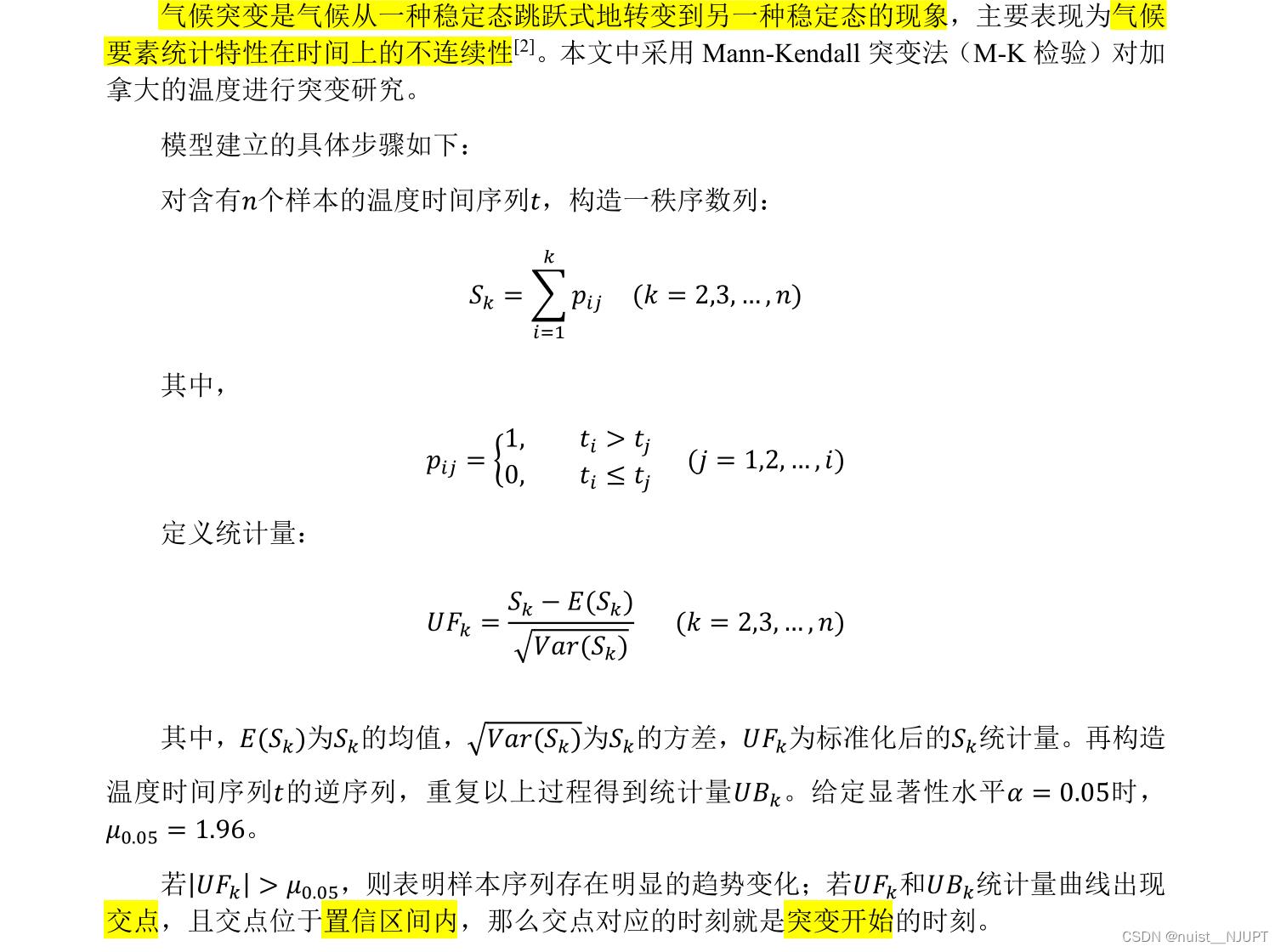
2.2、M-K检验的matlab实现
Data = [1961,4.7;
1962,4.98;
1963,5.39;
1964,5.72;
1965,4.88;
1966,5.02;
1967,5.1;
1968,5.19;
1969,4.31;
1970,4.86;
1971,5.28;
1972,4.9;
1973,5.23;
1974,4.6;
1975,5.88;
1976,4.58;
1977,5.37;
1978,5.24;
1979,4.91;
1980,4.84;
1981,4.98;
1982,5.54;
1983,5.67;
1984,4.31;
1985,4.67;
1986,4.49;
1987,4.96;
1988,5.18;
1989,5.41;
1990,6.06;
1991,5.4;
1992,5.38;
1993,5.3;
1994,6.18;
1995,5.58;
1996,5.2;
1997,5.8;
1998,6.81;
1999,6.47;
2000,6;
2001,6.16;
2002,6.42;
2003,6.7;
2004,6.18;
2005,5.52;
2006,6.46;
2007,6.73;
2008,5.86;
2009,5.61;
2010,5.31;
2011,5.69;
2012,5.05;
2013,5.13;
2014,6.09;
2015,6.13
] ;
y = Data(:,2);%平均温度序列
Sk = zeros(size(y)); % 定义累计量序列 Sk,长度 = y,初始值 =0,Sk(1) =0
UFk = zeros(size(y)); % 定义统计量 UFk,长度 = y,初始值 =0,UFk(1) =0
s = 0; % 定义 Sk 序列的元素 s
for i =2:length(y)
for j =1:i
if y(i) > y(j)
s = s +1;
else
s = s +0;
end
end
Sk(i) = s;
E = i* (i - 1) /4; % Sk(i)的均值,见式(3)
Var = i* (i - 1)* (2* i +5) /72; % Sk(i)方差,见式(3)
UFk(i) = (Sk(i)- E) /sqrt(Var);% 正序列 UF 值,见式(2)
end
Sk2 = zeros(size(y)); % 定义逆序累计量序列 Sk2,长度= y,初始值 =0,Sk(2) =0
UBk = zeros(size(y)); % 定义逆序统计量 UBk,长度 = y,初始值 =0,UBk(1) =0
s =0;
y2 = flipud(y); % 按时间序列逆转平均温度序列
for i =2:length(y2)
for j =1:i
if y2(i) > y2(j)
s = s +1;
else
s = s +0;
end
end
Sk2(i) = s;
E = i* (i - 1) /4; %均值
Var = i* (i - 1)* (2* i +5) /72; %方差
UBk(i) = 0 - (Sk2(i) - E) /sqrt(Var);
end
UBk2 = flipud(UBk); %逆序列 UB 值
x = Data(:,1);%年份序列
n = length(x);%年份序列的长度
figure %做图
plot(x,UFk,'r-','linewidth',1.5);%画 UF 线
hold on
plot(x,UBk2,'b-.','linewidth',1.5);%画 UB 线
plot(x,1.96* ones(n,1),'k:','linewidth',1);
axis([min(x),max(x),-5,5]);%设置 X 轴范围和间距
legend('UF 统计量','UB 统计量','0.05 显著水平');% 设置图例
xlabel('年 Year','FontName','TimesNewRoman','FontSize',10);%X 轴标题
ylabel('统计量 MK Value','FontName','TimesNewRoman','Fontsize',10);%Y 轴标题
hold on
plot(x,-1.96 * ones(n,1),'k:','linewidth',1);
plot(x,0 * ones(n,1),'k-. ','linewidth',1);% 图片绘制
由图可知,该地区 1961 ~2015 年气温呈显著上升趋势,UF 和 UB 统计量有交点
且交点在置信直线范围之间,表明气温在 1989 年前后发生了突变。

三、小波分析
3.1、小波分析基本理论
第一:去噪
小波分析的重要应用之一就是用于信号降噪。我们知道,一个含噪的一维信号模型可以表示为下图。其中s(k)为含噪信号,f(k)为有用信号,e(k)为噪声信号。这里我们认为e(k)是一个 1 级高斯白噪声,通常表现为高频信号,而实际工程中f(k)通常为低频信号或者是一些比较稳定的信号。
因此我们可按如下的方法进行降噪处理。首先对信号进行小波分解, 一般地,噪声信号多包含在具有较高频率的细节中,从而,可利用门限阈值等形式对所分解的小波系数进行处理,然后对信号进行小波重构即可达到对信号降噪的目的。对信号降噪实质上是抑制信号中的无用部分,恢复信号中有用部分的过程。
小波信号降噪一般分为以下三个步骤:
(1)确定小波分解的层数,对信号进行分解。
(2)确定各个分解层下细节信号的阈值,对细节信号进行阈值量化处理。
(3)利用阈值处理后的细节信号和逼近信号进行重构,得到降噪后的信号。
第二:周期变化分析
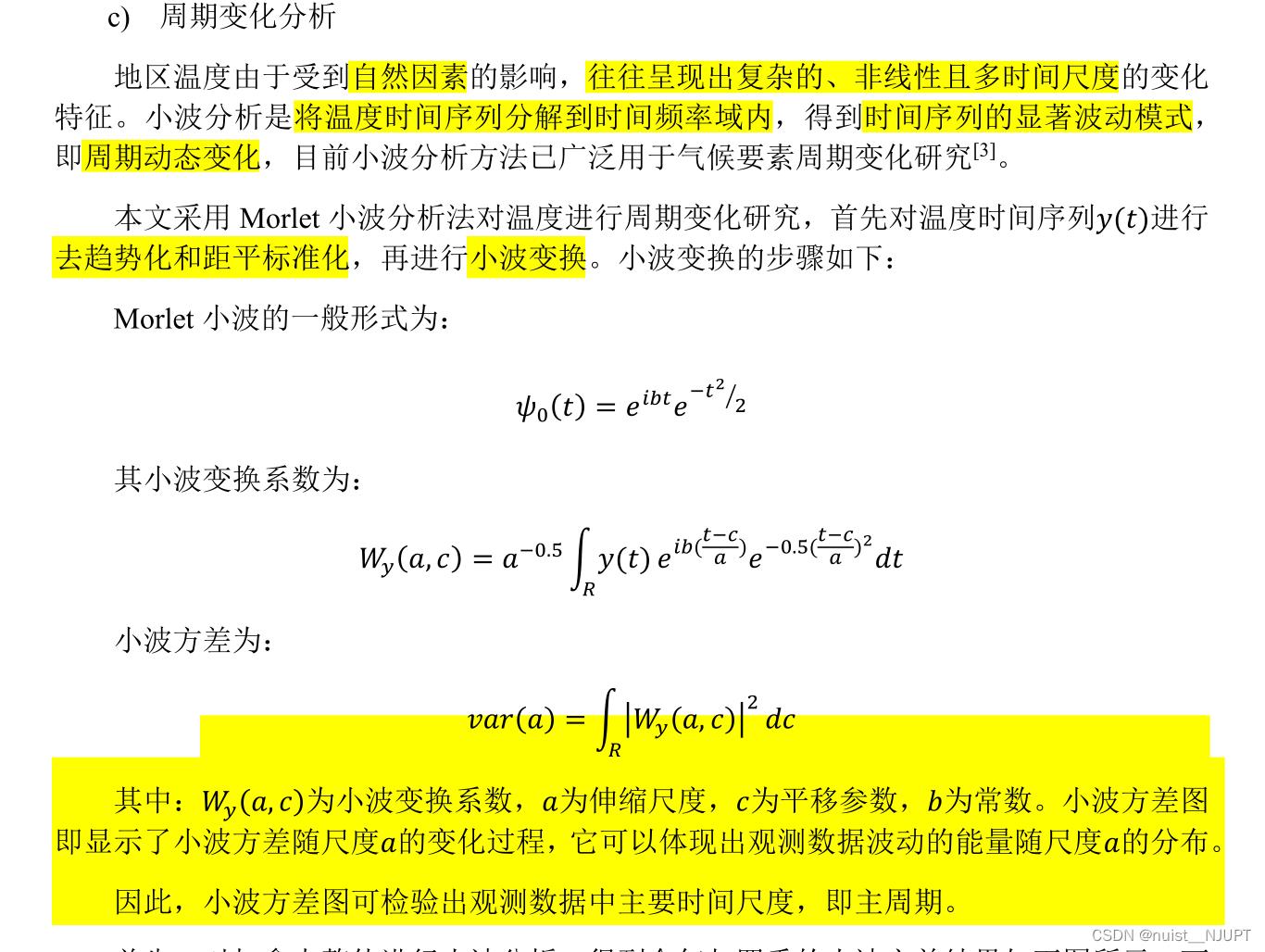
3.2、小波分析去噪matlab实现
clc;
clear all;
% 载入信号
% Load electrical signal and select a part of it.
load leleccum;
indx = 2600:3100;
%装载采集的信号
x = leleccum(indx);
lx=length(x);
t=[0:1:length(x)-1]';
%% 绘制监测所得信号
subplot(2,2,1);
plot(t,x);
title('原始信号');
grid on
%% 用db1小波对原始信号进行3层分解并提取小波系数
[c,l]=wavedec(x,3,'db1');
ca3=appcoef(c,l,'db1',3);
cd3=detcoef(c,l,3);
cd2=detcoef(c,l,2);
cd1=detcoef(c,l,1);
%% 对信号进行强制去噪处理并图示
cdd3=zeros(1,length(cd3));
cdd2=zeros(1,length(cd2));
cdd1=zeros(1,length(cd1));
c1=[ca3,cdd3,cdd2,cdd1];
x1=waverec(c1,l,'db1');
subplot(2,2,2);
plot(x1);
title('强制去噪后信号');
grid on
%% 默认阈值对信号去噪并图示%%
%用ddencmp( )函数获得信号的默认阈值,使用wdencmp( )函数实现去噪过程
[thr,sorh,keepapp]=ddencmp('den','wv',x);
x2=wdencmp('gbl',c,l,'db1',3,thr,sorh,keepapp);
subplot(2,2,3);
plot(x2);
title('默认阈值去噪后信号');
grid on
%% 给定的软阈值进行去噪处理并图示
wname = 'db3'; lev = 5;
[c,l] = wavedec(x,lev,wname);
alpha = 1.5; m = l(1);
[thr,nkeep] = wdcbm(c,l,alpha,m)
[xd,cxd,lxd,perf0,perfl2] = wdencmp('lvd',c,l,wname,lev,thr,'h');
subplot(2,2,4);
plot(xd);
title('给定软阈值去噪后信号');
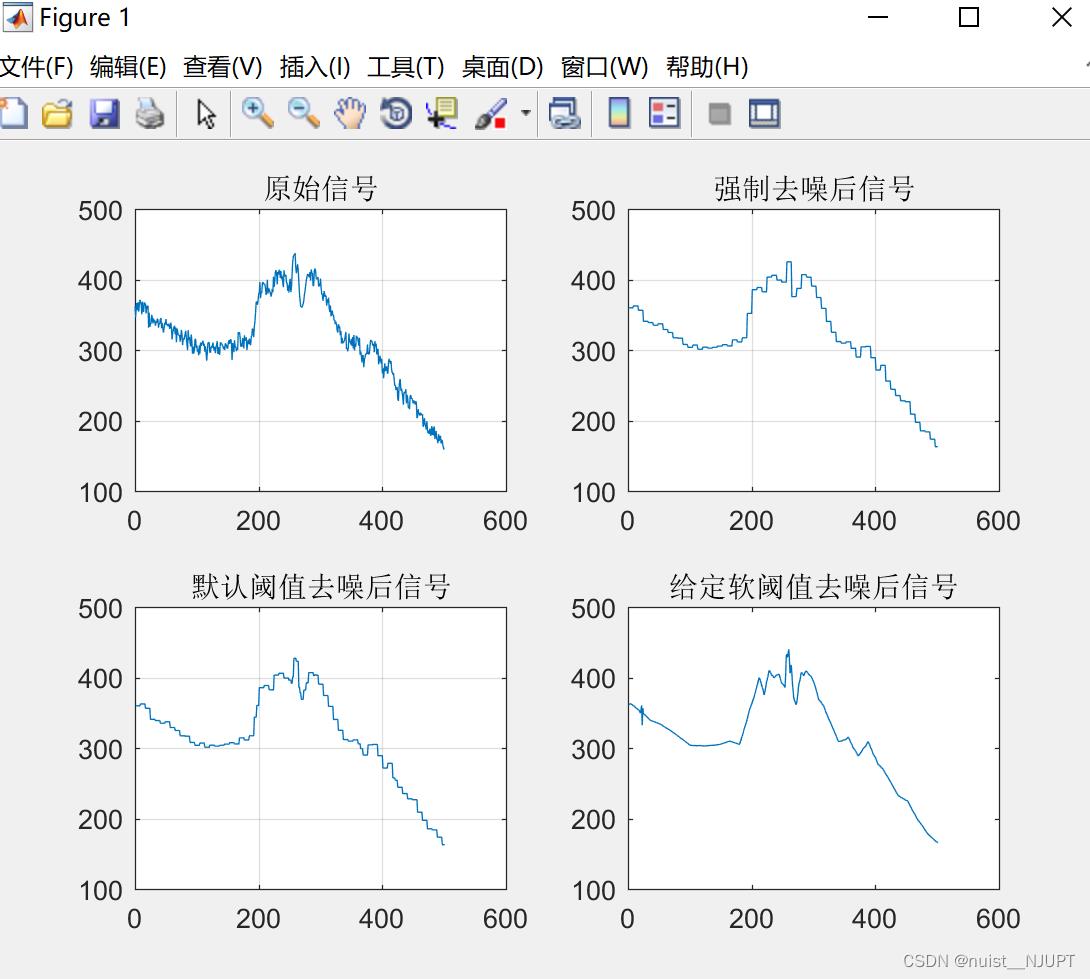
3.3、小波分析周期变化分析matlab实现
%1.xiaozao函数,是需要对标准化的序列进行消除数据噪音分析;
%2.Db3函数,是对数列进行Db3趋势分析;
%3.period函数,是求得时间序列的实部和模的平方。
%其中周期变化图是实部的等值线图
%而小波方差是模的平方的算数平均。
clc
clear
close all;
load 暴雨量.mat
start_year=1958
a=s(:,1);
b=zscore(a);
scales=[1:1:32];
%进行连续小波变换得到小波系数矩阵,选择复morlet小波函数
wf=cwt(b,scales,'cmor1-1'); %计算小波系数
shibu=real(wf);% 求得系数的实部
mo=abs(wf); %计算小波系数模的绝对值
mofang=mo.^2; %计算小波系数的模方
fangcha=mean(mofang,2); %计算小波方差,小波方差是模的平方的算数平均
%**********画小波实部*************
figure(1);
j = j + 1;
% subplot(121);
% axis([1961,2015,0,50]);
width=713;%宽度,像素数
height=493;%高度
left=300;%距屏幕左下角水平距离
bottem=200;%距屏幕左下角垂直距离
set(gcf,'position',[left,bottem,width,height])
contourf(shibu,10,'-');
colormap('Jet');
colorbar;
hold on
set(gca,'FontSize',13,'Fontname', 'Times New Roman','Fontweight','bold');
xlabel('Year/a','FontName','Times new roman','FontSize',16,'Fontweight','bold');
ylabel('Scales/year','FontName','Times new roman','FontSize',16,'Fontweight','bold');
%set(gca,'XTick',1965:5:2017);
%set(gca,'XTicklabel', 1962:1:2017); %更新XTickLabel
set(gca,'xlim',[1 length(s)],'XTick',1:roundn(length(s)/5,0):length(s),'XTickLabel',start_year:roundn(length(s)/5,0):(start_year+length(s)-1))%修改横坐标的范围
title('(a)','Fontname','Times new roman','FontSize',18,'Fontweight','bold','position',[-4,52]);
%saveas(gca,[path_out5,num2str(j)],'png');
%close;
%********小波方差*************%
figure(2);
j = j + 1;
width=713;%宽度,像素数
height=493;%高度
left=300;%距屏幕左下角水平距离
bottem=200;%距屏幕左下角垂直距离
set(gcf,'position',[left,bottem,width,height])
% subplot(122);
plot(fangcha,'k-','linewidth',1.5);
set(gca,'FontName','Times new roman','FontSize',16,'Fontweight','bold');
xlabel('Scales/year','FontName','Times new roman','FontSize',16,'Fontweight','bold');
ylabel('Variance','FontName','Times new roman','FontSize',16,'Fontweight','bold');
title('(b)','Fontname','Times new roman','FontSize',18,'Fontweight','bold','position',[-3,1.8]);
set(gca,'XTick',0:5:31);
axis([1 32 0 2]);
grid on;
%saveas(gca,[path_out5,num2str(j)],'png');
%close;
%********小波模**************%
figure(3);
j = j + 1;
%subplot(122);
width=713;%宽度,像素数
height=493;%高度
left=300;%距屏幕左下角水平距离
bottem=200;%距屏幕左下角垂直距离
set(gcf,'position',[left,bottem,width,height])
contourf(mo,10,'-');
colormap('Jet');
colorbar;
hold on
set(gca,'FontName','Times new roman','FontSize',13,'Fontweight','bold');
xlabel('Year','FontName','Times new roman','FontSize',16,'Fontweight','bold');
ylabel('Scales/year','FontName','Times new roman','FontSize',16,'Fontweight','bold');
title('(c)','Fontname','Times new roman','FontSize',18,'Fontweight','bold','position',[-4,52]);
set(gca,'xlim',[1 length(s)],'XTick',1:roundn(length(s)/5,0):length(s),'XTickLabel',start_year:roundn(length(s)/5,0):(start_year+length(s)-1))
%saveas(gca,[path_out5,num2str(j)],'png');
%close;
%********小波模方**************%
figure(4);
j = j + 1;
%subplot(122);
width=713;%宽度,像素数
height=493;%高度
left=300;%距屏幕左下角水平距离
bottem=200;%距屏幕左下角垂直距离
set(gcf,'position',[left,bottem,width,height])
contourf(mofang,10,'-');
colormap('Jet');
colorbar;
hold on
set(gca,'FontName','Times new roman','FontSize',13,'Fontweight','bold');
xlabel('Year','FontName','Times new roman','FontSize',16,'Fontweight','bold');
ylabel('Scales/year','FontName','Times new roman','FontSize',16,'Fontweight','bold');
set(gca,'xlim',[1 length(s)],'XTick',1:roundn(length(s)/5,0):length(s),'XTickLabel',start_year:roundn(length(s)/5,0):(start_year+length(s)-1))
%saveas(gca,[path_out5,num2str(j)],'png');小波实部等值线图如下:
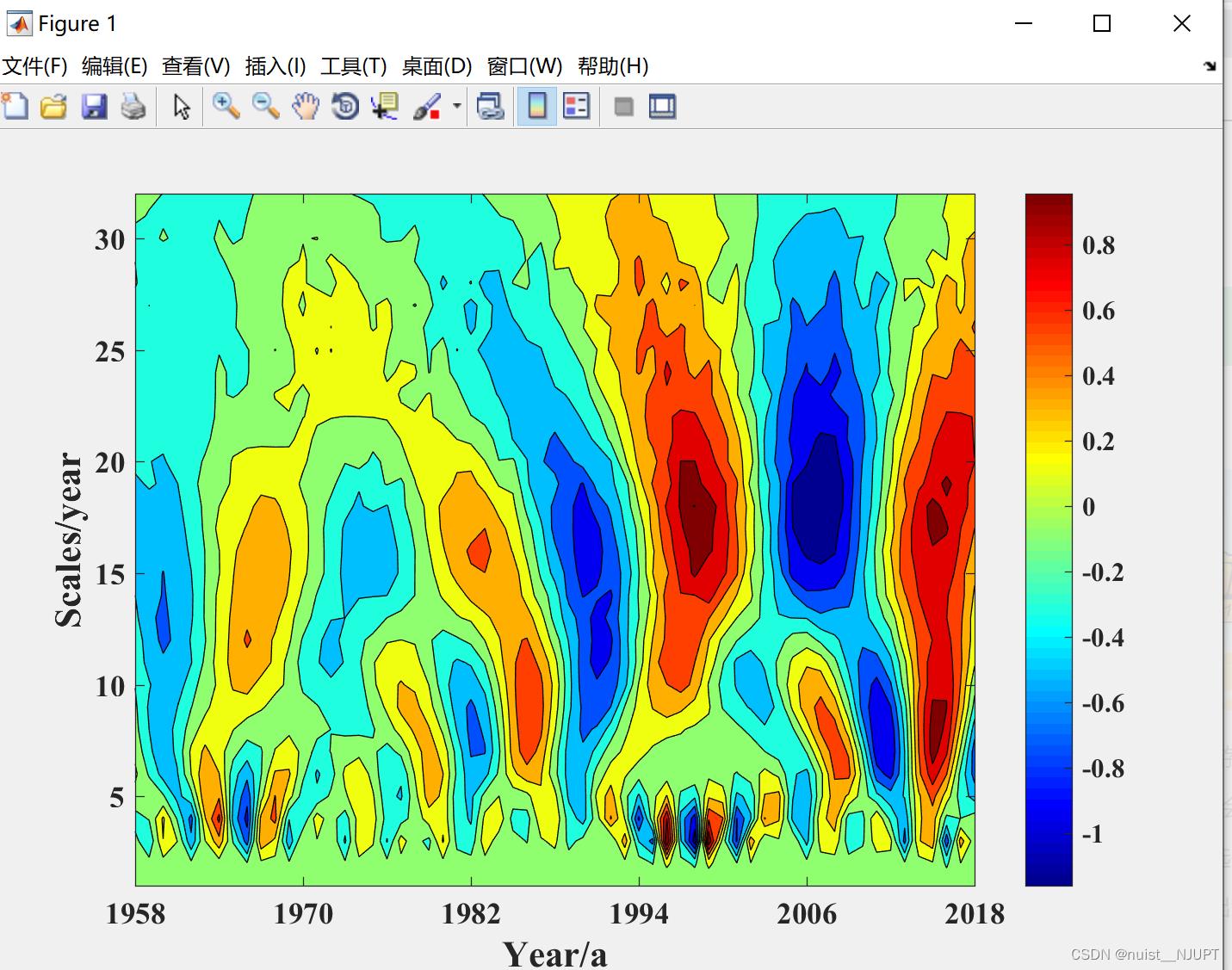
小波方差图如下:
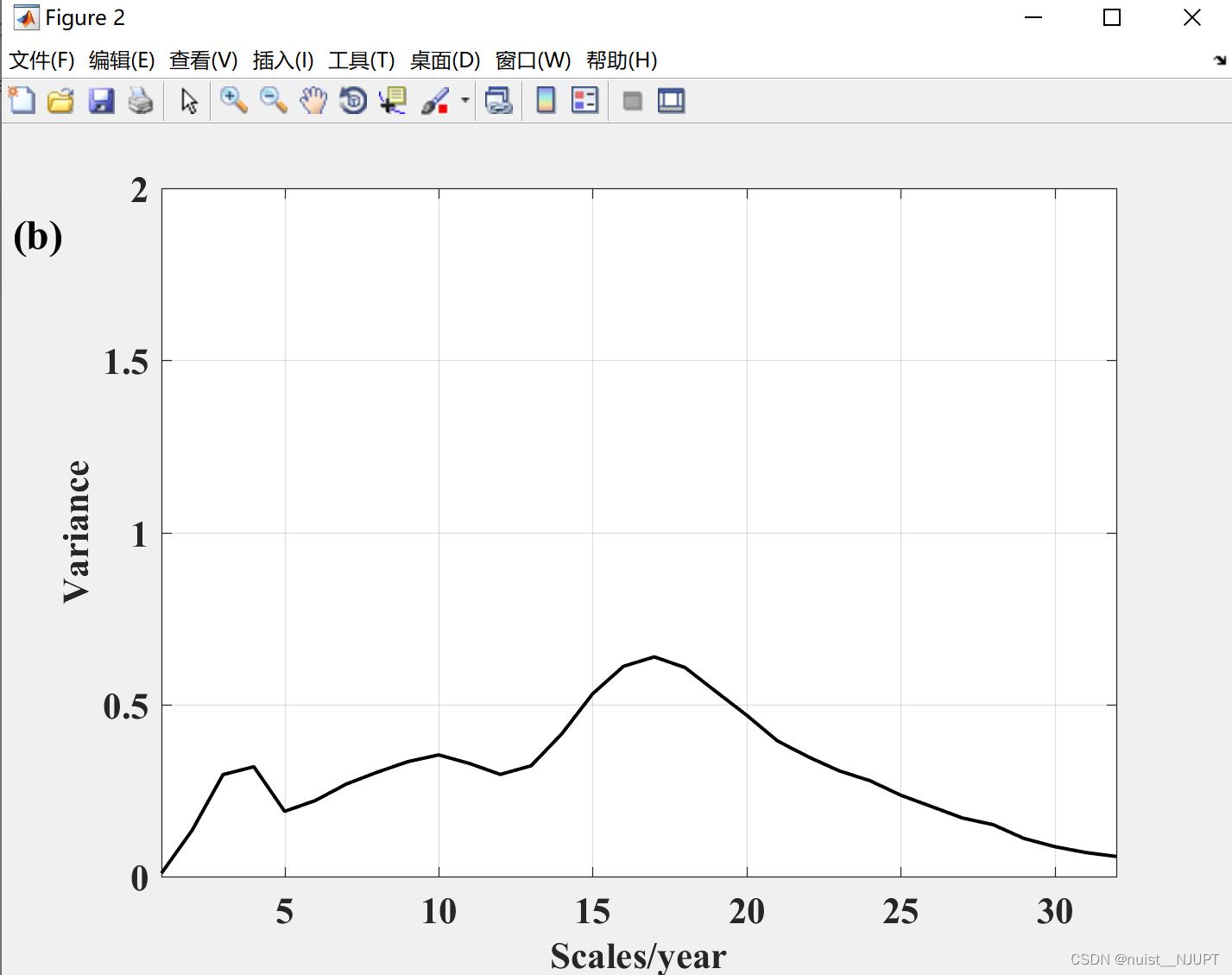
小波模等值线图如下: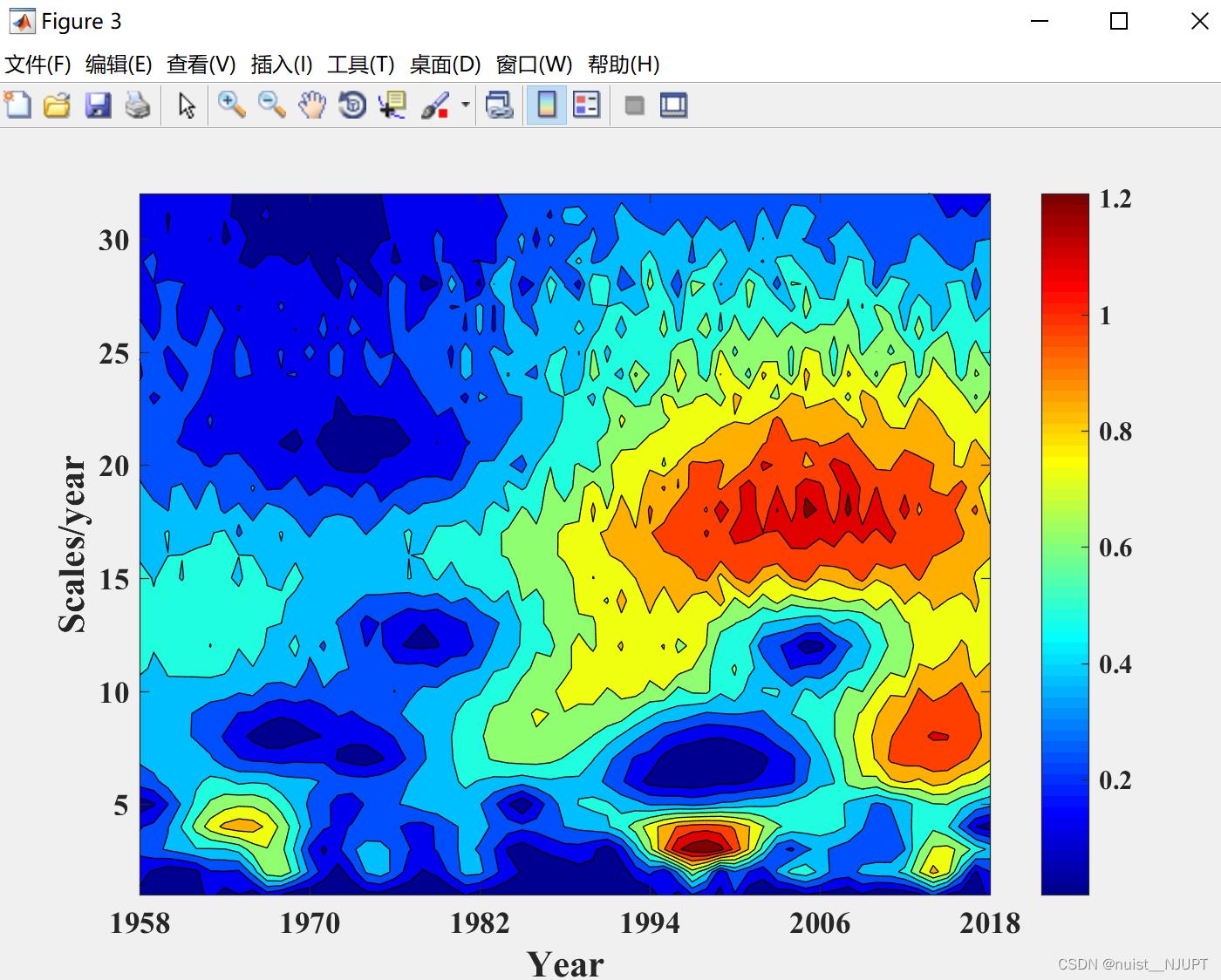
小波模方的等值线图: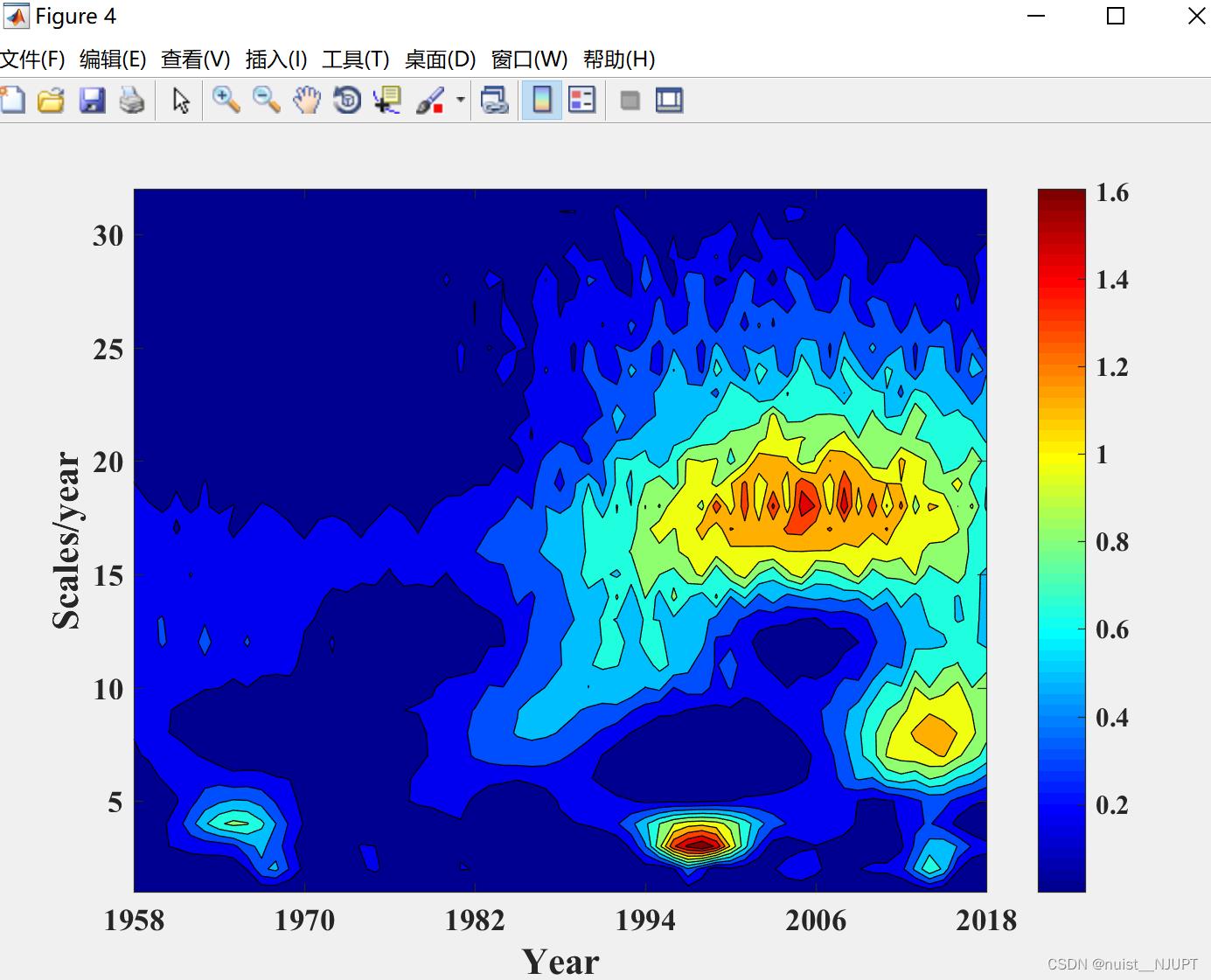
四、机器学习的常见树模型
由于之前的博客介绍了决策树和随机森林,这次主要介绍AdaBoost,GDBT,XGBoost,LigthGBM四种模型的理论及实现过程。
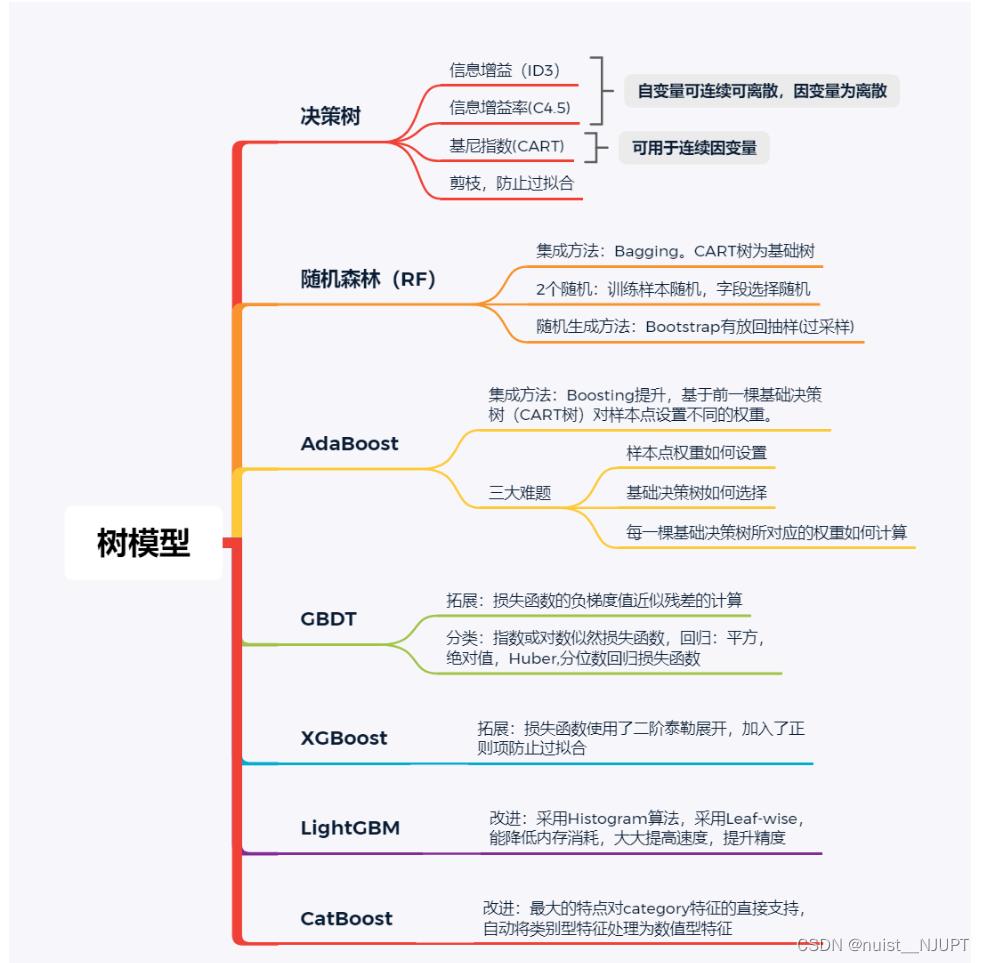
4.1、AdaBoost模型的基本思想和算法流程
Adaboost是一种迭代算法,其核心思想是针对同一个训练集训练不同的分类器(弱分类器),然后把这些弱分类器集合起来,构成一个更强的最终分类器(强分类器)。
我们看一下Adaboost的模型,就是给分类误差小的分类器分配更多的权值,给分类误差大的分类器分配更大的权值。
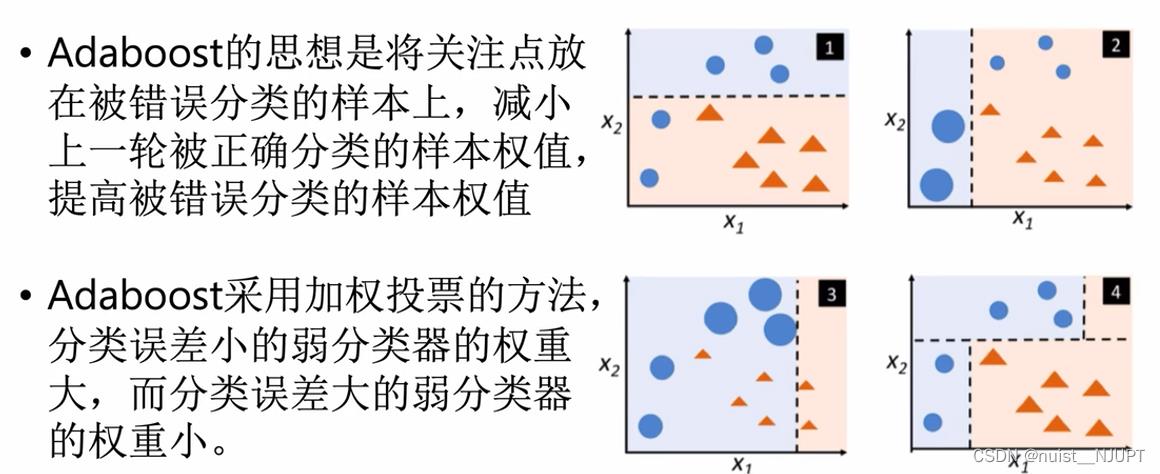
我们看一下Adaboost的具体实现流程,首先输入训练样本x和y,然后初始化训练样本的权值分布,具体如下:

接下来进行遍历得到所有的弱分类器和所有的权值,具体如下:

最后得到最终的分类器如下:

该算法其实是一个简单的弱分类算法提升过程,这个过程通过不断的训练,可以提高对数据的分类能力。整个过程如下所示:
1. 先通过对N个训练样本的学习得到第一个弱分类器;
2. 将分错的样本和其他的新数据一起构成一个新的N个的训练样本,通过对这个样本的学习得到第二个弱分类器 ;
3. 将1和2都分错了的样本加上其他的新样本构成另一个新的N个的训练样本,通过对这个样本的学习得到第三个弱分类器;
4. 最终经过提升的强分类器。即某个数据被分为哪一类要由各分类器权值决定。
4.2、AdaBoost模型的具体实现
下面使用python实现该模型的算法,完成一个二分类任务,我们使用Sklearn中的AdaBoost接口进行实践,具体如下:
import numpy as np
import matplotlib.pyplot as plt
from sklearn.ensemble import AdaBoostClassifier
from sklearn.tree import DecisionTreeClassifier
from sklearn.datasets import make_gaussian_quantiles
# 用make_gaussian_quantiles生成多组多维正态分布的数据
# 生成2维正态分布,设定样本数1000,协方差2
#其中x1是200行2列的数据,y1是200个输出样本表示分类结果
x1, y1 = make_gaussian_quantiles(
cov=2., n_samples=200, n_features=2, n_classes=2, shuffle=True, random_state=1)
# 为了增加样本分布的复杂度,再生成一个数据分布
#x2是300行2列的数据,y2是300个输出样本表示分类结果
x2, y2 = make_gaussian_quantiles(mean=(
3, 3), cov=1.5, n_samples=300, n_features=2, n_classes=2, shuffle=True, random_state=1)
#合并X水平合并,y竖直合并,然后按0和1不同颜色绘制散点图
X=np.vstack((x1,x2))
y=np.hstack((y1,1-y2))
# 绘制生成数据
plt.scatter(X[:,0],X[:,1],c=y)
plt.show()
#设定弱分类器CART
weakClassifier=DecisionTreeClassifier(max_depth=2)
#构建模型并进行训练
clf=AdaBoostClassifier(base_estimator=weakClassifier,algorithm='SAMME',n_estimators=300,learning_rate=0.8)
clf.fit(X, y)
# 模型预测
x1_min=X[:,0].min()-1
x1_max=X[:,0].max()+1
x2_min=X[:,1].min()-1
x2_max=X[:,1].max()+1
x1_,x2_=np.meshgrid(np.arange(x1_min,x1_max,0.02),np.arange(x2_min,x2_max,0.02))
y_=clf.predict(np.c_[x1_.ravel(),x2_.ravel()])
print(y)
# 结果绘制
#绘制分类效果
y_=y_.reshape(x1_.shape)
plt.contourf(x1_,x2_,y_,cmap=plt.cm.Paired)
plt.scatter(X[:,0],X[:,1],c=y)
plt.show()原始的散点图与分类后的效果图如下:
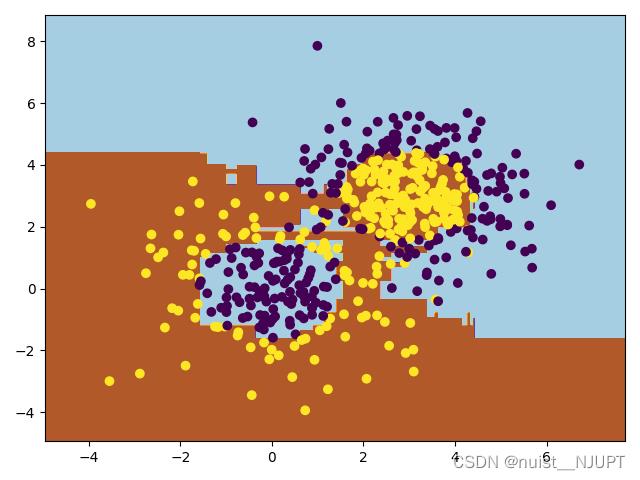
4.3、GBDT(梯度提升决策树)基本理论
我们看一下GDBT模型,就是梯度提升+决策树,利用损失函数的负梯度尽心你和学习器。

我们具体看一下为什么可以在GDBT模型中使用负梯度作为残差进行拟合,具体如下:

我们看一下这个GDBT的梯度提升的流程,具体如下:
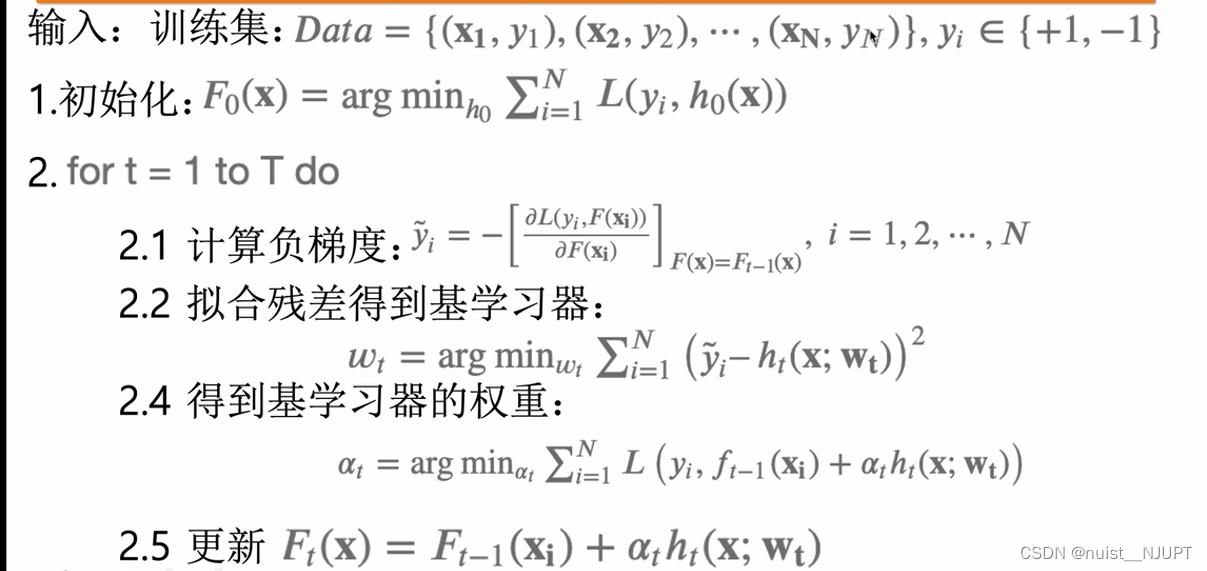
4.4、XGBoost的基本理论
我们看一下XGBoost是GBBT模型的一种,XGBoost提供并行树提升(也称为GBDT,GBM),可以快速准确地解决许多数据科学问题。
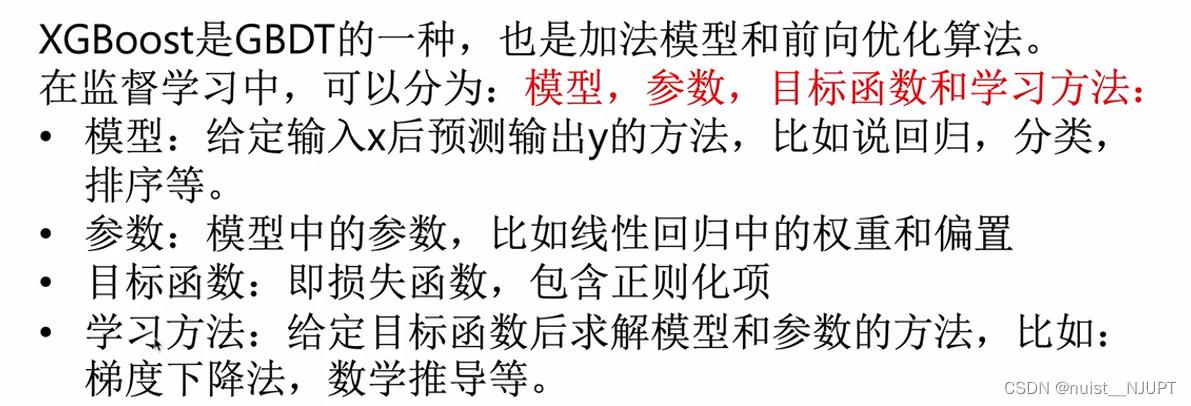
我们先回顾一下决策树的概念,就是将不用的类别映射到叶子节点的概率进行分类和回归。
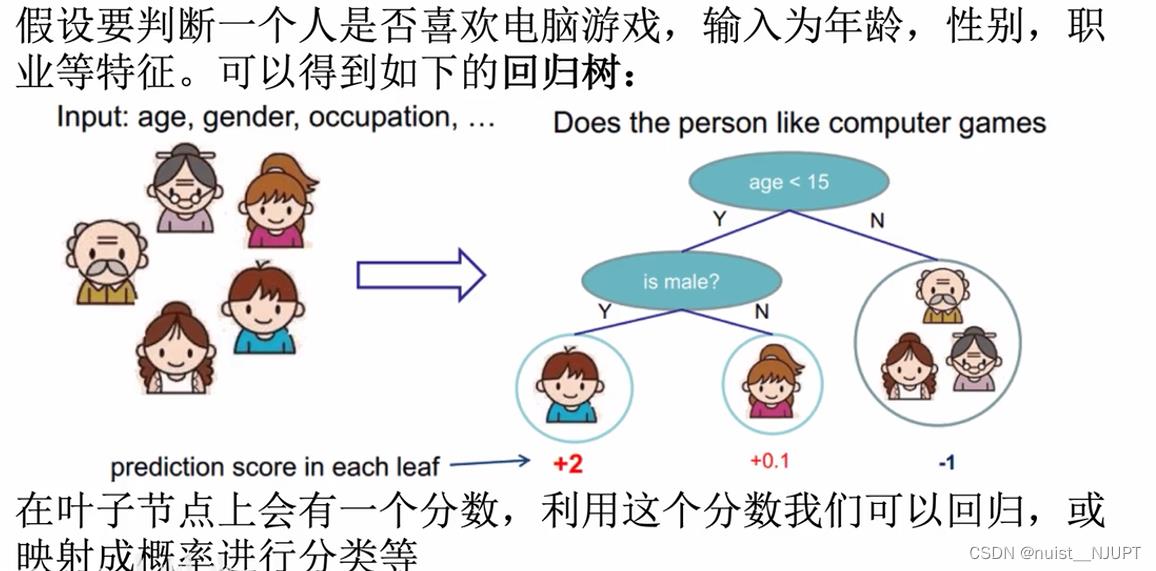
使用单个树进行集成学习的能力优先,一般考虑使用多棵树进行集成学习,就是随机森林或者提升树。
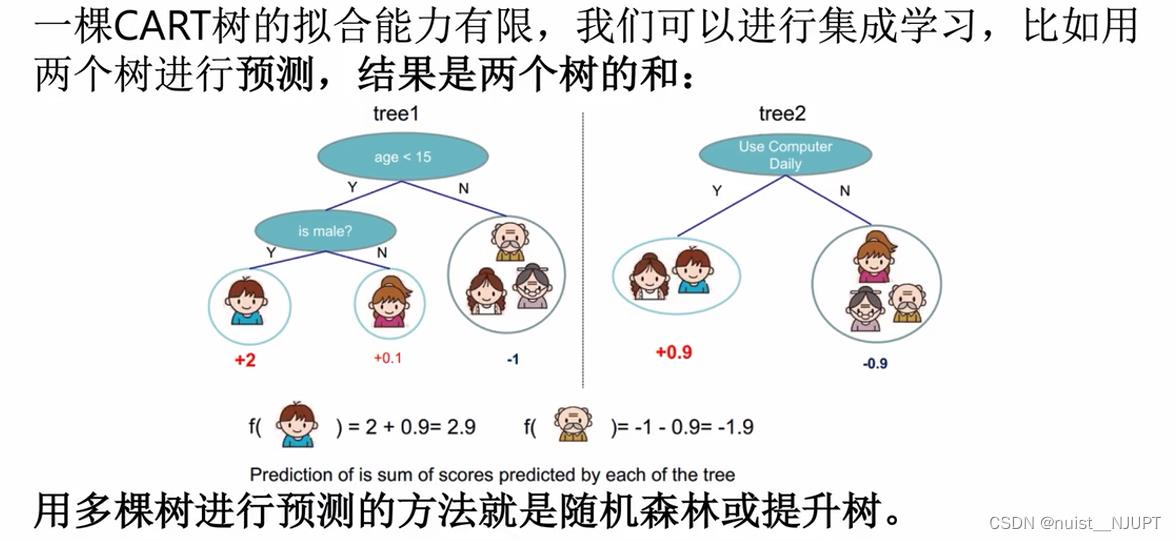
对于XGBoost的模型形式如下:是利用向前分布算法,学习到包含K棵树的加法模型。
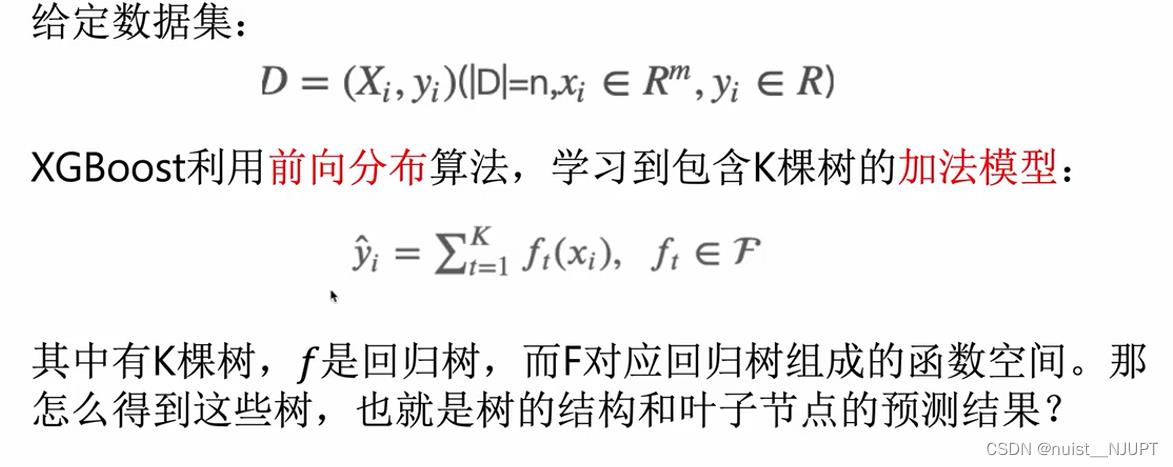
4.5、XGBoost的实践(分类和回归)
分类问题,根据输入特征进行学习生成多个弱学习器,将多个弱学习器组合成一个强学习器,通过强学习器进行预测,输入的多组数据一共包含四个特征,输入的分类一共为3类:
import xgboost as xgb
from xgboost import plot_importance,plot_tree
from sklearn.datasets import load_iris
from sklearn.model_selection import train_test_split
from sklearn.metrics import accuracy_score
import matplotlib.pyplot as plt
# 加载样本数据集
#X有四个特征,y有三个类别:0,1,2
iris = load_iris()
X,y = iris.data,iris.target
# 获取特征名称:四个名称
feature_name = iris.feature_names
# 数据分割
X_train, X_test, y_train, y_test = train_test_split(X, y, test_size=0.2, random_state=3)
# 模型训练
model = xgb.XGBClassifier(max_depth=5, n_estimators=50, silent=True, objective='multi:softmax',feature_names=feature_name)
model.fit(X_train, y_train)
# 预测
y_pred = model.predict(X_test)
print(y_pred)
# 计算准确率
accuracy = accuracy_score(y_test,y_pred)
print("accuarcy: %.2f%%" % (accuracy*100.0))
# 显示重要特征
plot_importance(model)
plot_tree(model,num_trees=5)
plt.show()测试集预测的结果如下,一共分为三类,即0,1,2.

四个特征的重要性排名如下:

绘制的决策树如下:

回归问题:
根据输入特征和输出特征进行回归,输入的多组数据的特征数目是9个,对结果进行预测,代码如下:
import xgboost as xgb
from xgboost import plot_importance,plot_tree
from sklearn.model_selection import train_test_split
from sklearn.datasets import load_boston
import matplotlib.pyplot as plt
# 获取数据
boston = load_boston()
X,y = boston.data,boston.target
# 数据集划分
X_train, X_test, y_train, y_test = train_test_split(X, y, test_size=0.2, random_state=0)
# 模型训练
model = xgb.XGBRegressor(max_depth=5, learning_rate=0.1, n_estimators=50, silent=True, objective='reg:gamma')
model.fit(X_train, y_train)
# 预测
y_pred = model.predict(X_test)
print(y_pred)
# 显示重要特征
plot_importance(model)
# 可视化树的生成情况,num_trees是树的索引
plot_tree(model, num_trees=17)
plt.show()回归的预测结果如下:
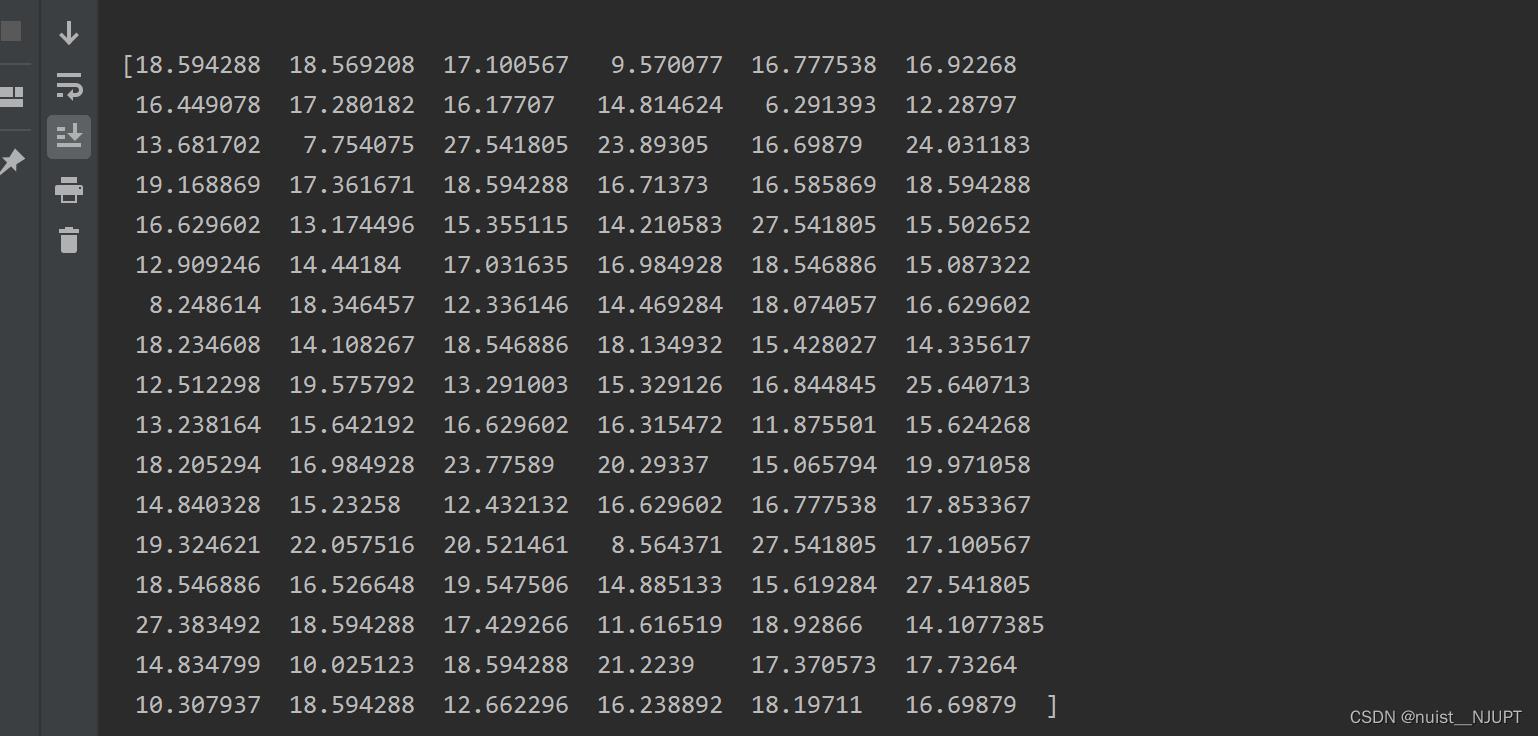
对9个特征的重要性进行排名如下:
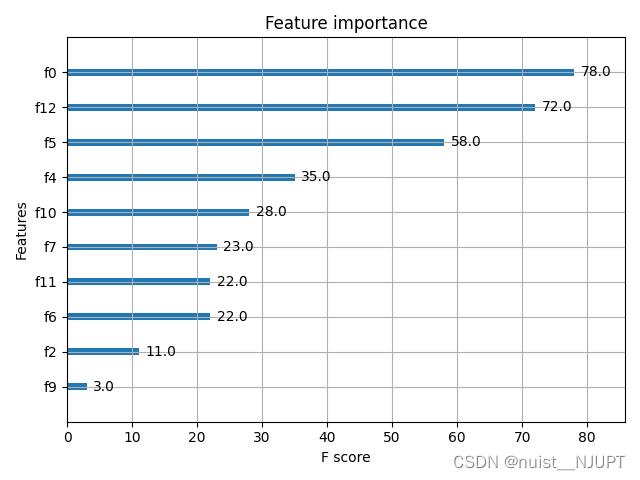
绘制的决策树如下所示:
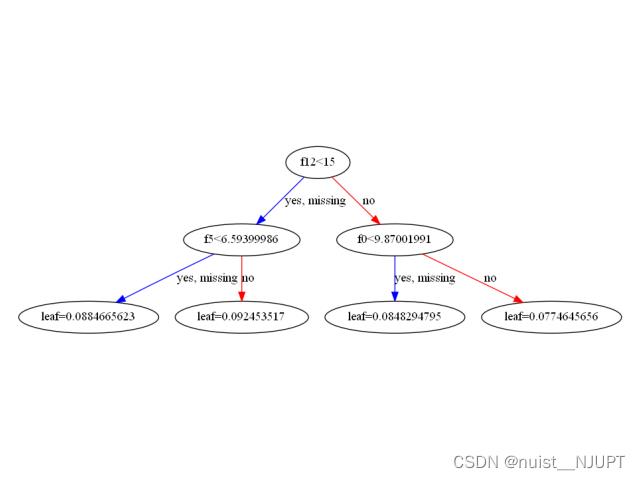
五、支持向量机SVM
5.1、支持向量机基本理论
支持向量机(Support Vector Machine, SVM)是一类按监督学习(supervised learning)方式对数据进行二元分类的广义线性分类器(generalized linear classifier),其决策边界是对学习样本求解的最大边距超平面(maximum-margin hyperplane) 。
支持向量机可以用于分类,回归预测和时间序列预测。
5.2、SVM实现持向量机回归(SVR)模型
我们将数据划分为训练集和测试集,训练集有354组数据和13个特征,测试集是152组数据和13个特征,对数据进行回归预测,matlab的代码如下:
close all;
clc
clear
%% 下载数据
load('p_train.mat');
load('p_test.mat');
load('t_train.mat');
load('t_test.mat');
%% 数据归一化
%输入样本归一化
[pn_train,ps1] = mapminmax(p_train');
pn_train = pn_train';
pn_test = mapminmax('apply',p_test',ps1);
pn_test = pn_test';
%输出样本归一化
[tn_train,ps2] = mapminmax(t_train');
tn_train = tn_train';
tn_test = mapminmax('apply',t_test',ps2);
tn_test = tn_test';
%% SVR模型创建/训练
% 寻找最佳c参数/g参数——交叉验证方法
% SVM模型有两个非常重要的参数C与gamma。
% 其中 C是惩罚系数,即对误差的宽容度。
% c越高,说明越不能容忍出现误差,容易过拟合。C越小,容易欠拟合。C过大或过小,泛化能力变差
% gamma是选择RBF函数作为kernel后,该函数自带的一个参数。隐含地决定了数据映射到新的特征空间后的分布,
% gamma越大,支持向量越少,gamma值越小,支持向量越多。支持向量的个数影响训练与预测的速度。
[c,g] = meshgrid(-10:0.5:10,-10:0.5:10);
[m,n] = size(c);
cg = zeros(m,n);
eps = 10^(-4);
v = 5;
bestc = 0;
bestg = 0;
error = Inf;
for i = 1:m
for j = 1:n
cmd = ['-v ',num2str(v),' -t 2',' -c ',num2str(2^c(i,j)),' -g ',num2str(2^g(i,j) ),' -s 3 -p 0.1'];
cg(i,j) = svmtrain(tn_train,pn_train,cmd);
if cg(i,j) < error
error = cg(i,j);
bestc = 2^c(i,j);
bestg = 2^g(i,j);
end
if abs(cg(i,j) - error) <= eps && bestc > 2^c(i,j)
error = cg(i,j);
bestc = 2^c(i,j);
bestg = 2^g(i,j);
end
end
end
% 创建/训练SVR
cmd = [' -t 2',' -c ',num2str(bestc),' -g ',num2str(bestg),' -s 3 -p 0.01'];
model = svmtrain(tn_train,pn_train,cmd);
%% SVR仿真预测
% [Predict_1,error_1,dec_values_1] = svmpredict(tn_train,pn_train,model);
[Predict_2,error_2,dec_values_2] = svmpredict(tn_test,pn_test,model);
% 反归一化
% predict_1 = mapminmax('reverse',Predict_1,ps2);
predict_2 = mapminmax('reverse',Predict_2,ps2);
%% 计算误差
[len,~]=size(predict_2);
error = t_test - predict_2;
error = error';
MAE1=sum(abs(error./t_test'))/len;
MSE1=error*error'/len;
RMSE1=MSE1^(1/2);
R = corrcoef(t_test,predict_2);
r = R(1,2);
disp(['........支持向量回归误差计算................'])
disp(['平均绝对误差MAE为:',num2str(MAE1)])
disp(['均方误差为MSE:',num2str(MSE1)])
disp(['均方根误差RMSE为:',num2str(RMSE1)])
disp(['决定系数 R^2为:',num2str(r)])
figure(1)
plot(1:length(t_test),t_test,'r-*',1:length(t_test),predict_2,'b:o')
grid on
legend('真实值','预测值')
xlabel('样本编号')
ylabel('值')
string_2 = '测试集预测结果对比';
title(string_2)预测效果如下:
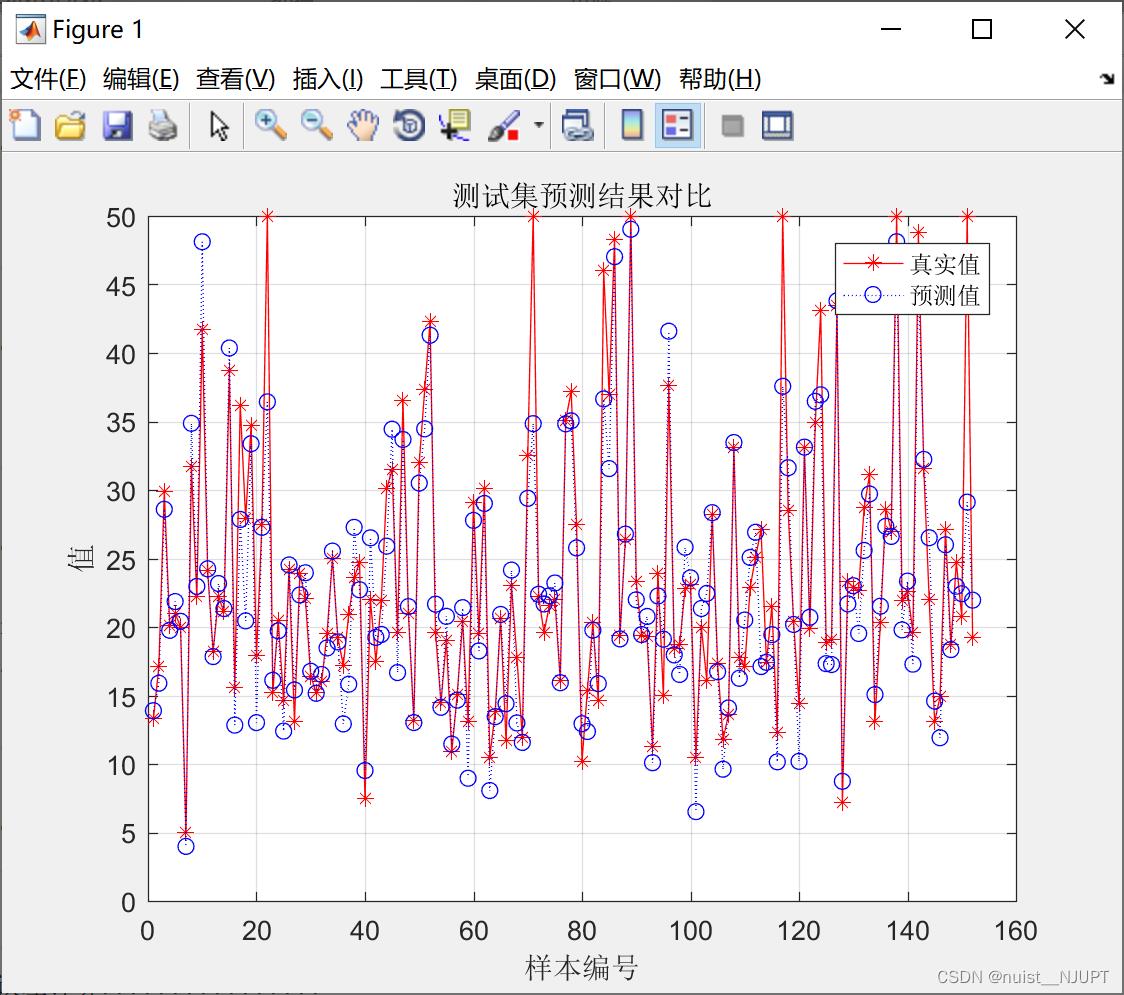
5.3、SVM实现分类任务
下面是使用SVM实现对红酒分类的预测,一共187组数据,13个特征,输出的类别为3类。
%% Matlab神经网络43个案例分析
% 基于SVM的数据分类预测——意大利葡萄酒种类识别
%% 清空环境变量
close all;
clear;
clc;
format compact;
%% 数据提取
% 载入测试数据wine,其中包含的数据为classnumber = 3,wine:178*13的矩阵,wine_labes:178*1的列向量
load chapter_WineClass.mat;
% 画出测试数据的box可视化图
figure;
boxplot(wine,'orientation','horizontal','labels',categories);
title('wine数据的box可视化图','FontSize',12);
xlabel('属性值','FontSize',12);
grid on;
% 画出测试数据的分维可视化图
figure
subplot(3,5,1);
hold on
for run = 1:178
plot(run,wine_labels(run),'*');
end
xlabel('样本','FontSize',10);
ylabel('类别标签','FontSize',10);
title('class','FontSize',10);
for run = 2:14
subplot(3,5,run);
hold on;
str = ['attrib ',num2str(run-1)];
for i = 1:178
plot(i,wine(i,run-1),'*');
end
xlabel('样本','FontSize',10);
ylabel('属性值','FontSize',10);
title(str,'FontSize',10);
end
% 选定训练集和测试集
% 将第一类的1-30,第二类的60-95,第三类的131-153做为训练集
train_wine = [wine(1:30,:);wine(60:95,:);wine(131:153,:)];
% 相应的训练集的标签也要分离出来
train_wine_labels = [wine_labels(1:30);wine_labels(60:95);wine_labels(131:153)];
% 将第一类的31-59,第二类的96-130,第三类的154-178做为测试集
test_wine = [wine(31:59,:);wine(96:130,:);wine(154:178,:)];
% 相应的测试集的标签也要分离出来
test_wine_labels = [wine_labels(31:59);wine_labels(96:130);wine_labels(154:178)];
%% 数据预处理
% 数据预处理,将训练集和测试集归一化到[0,1]区间
[mtrain,ntrain] = size(train_wine);
[mtest,ntest] = size(test_wine);
dataset = [train_wine;test_wine];
% mapminmax为MATLAB自带的归一化函数
[dataset_scale,ps] = mapminmax(dataset',0,1);
dataset_scale = dataset_scale';
train_wine = dataset_scale(1:mtrain,:);
test_wine = dataset_scale( (mtrain+1):(mtrain+mtest),: );
%% SVM网络训练
tic;
model = svmtrain(train_wine_labels, train_wine, '-c 2 -g 1');
toc;
%% SVM网络预测
tic;
[predict_label, accuracy,dec_value1] = svmpredict(test_wine_labels, test_wine, model);
toc;
%% 结果分析
% 测试集的实际分类和预测分类图
% 通过图可以看出只有一个测试样本是被错分的
figure;
hold on;
plot(test_wine_labels,'o');
plot(predict_label,'r*');
xlabel('测试集样本','FontSize',12);
ylabel('类别标签','FontSize',12);
legend('实际测试集分类','预测测试集分类');
title('测试集的实际分类和预测分类图','FontSize',12);
grid on;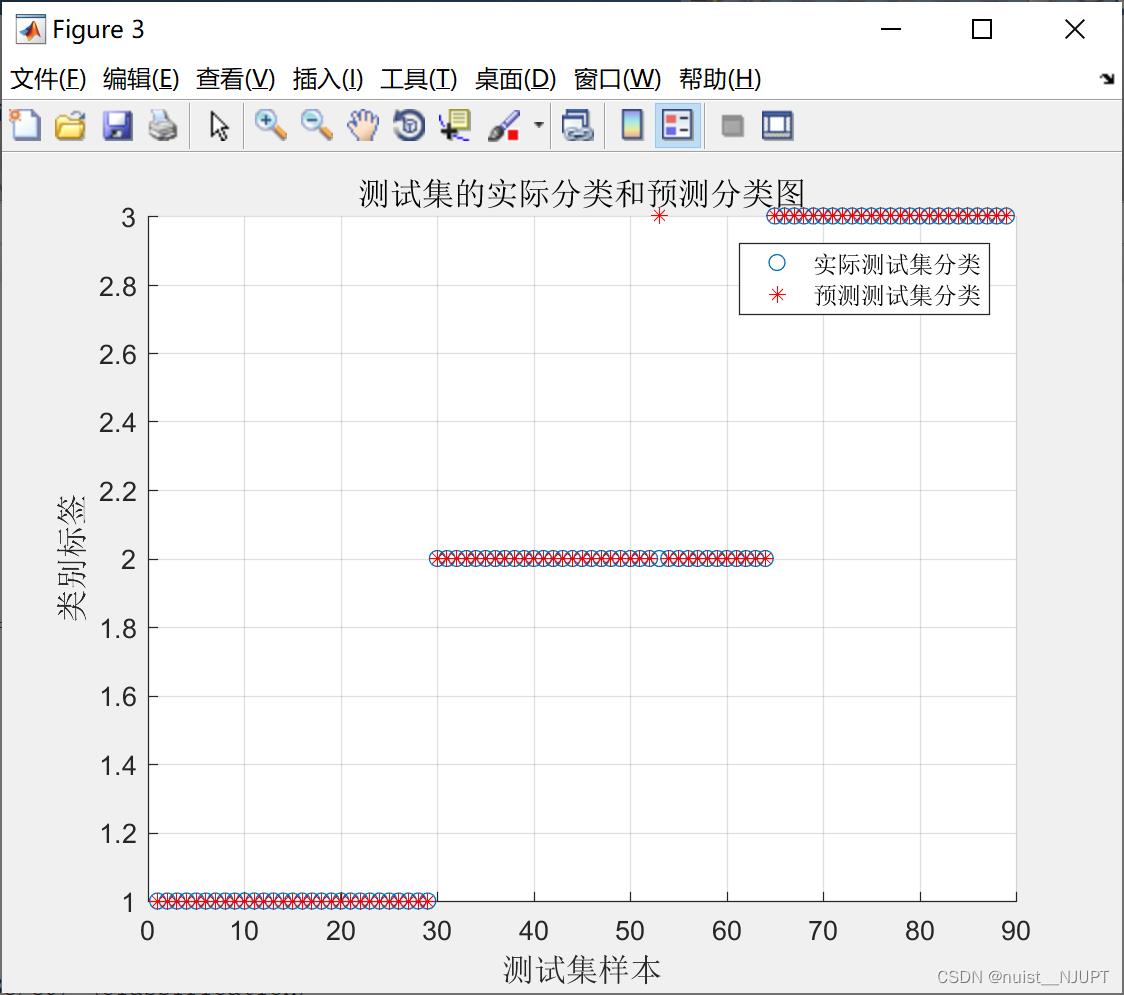
5.4、SVM实现时间序列预测
我们看一下SVM对于时间序列的预测,数据如下,第1列为时间,后面3列为时间的序列的数据,根据svm模型对时间序列数据进行预测,首先绘制B,C,D三类的时间序列变化图。

绘制出时间序列变化图,具体的时间序列变化如下所示,三组都是400个时间序列的样本数据。
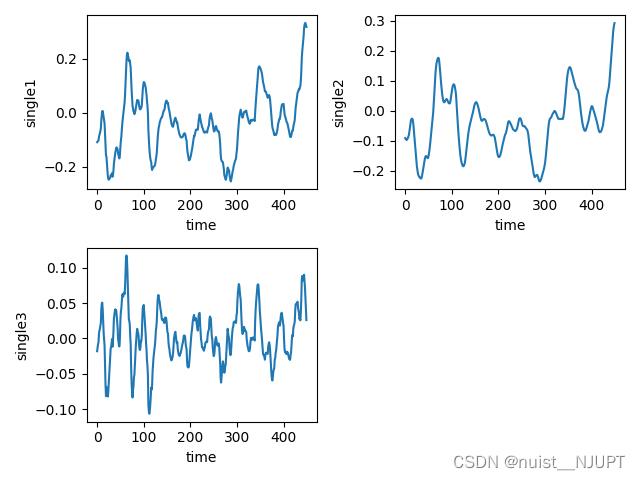
模型训练与预测的代码如下,对测试集进行预测,绘制预测值和真实值的曲线,最后绘制预测误差的曲线。
#time时间列,single1,信号值,取前多少个X_data预测下一个数据
def time_slice(time,single,X_lag):
sample = []
label = []
for k in range(len(time) - X_lag - 1):
t = k + X_lag
sample.append(single[k:t])
label.append(single[t + 1])
return sample,label
sample,label = time_slice(time,single1,5)
# 数据集划分
X_train, X_test, y_train, y_test = train_test_split(sample, label, test_size=0.3, random_state=42)
# 数据集掷乱
random_seed = 13
X_train, y_train = shuffle(X_train, y_train, random_state=random_seed)
# 参数设置SVR准备
parameters = 'kernel': ['rbf'], 'gamma': np.logspace(-5, 0, num=6, base=2.0),
'C': np.logspace(-5, 5, num=11, base=2.0)
# 网格搜索:选择十折交叉验证
svr = svm.SVR()
grid_search = GridSearchCV(svr, parameters, cv=10, n_jobs=4, scoring='neg_mean_squared_error')
# SVR模型训练
grid_search.fit(X_train, y_train)
# 输出最终的参数
print(grid_search.best_params_)
# 模型的精度
print(grid_search.best_score_)
# SVR模型保存
joblib.dump(grid_search, 'svr.pkl')
# SVR模型加载
svr = joblib.load('svr.pkl')
# SVR模型测试
y_hat = svr.predict(X_test)
# 计算预测值与实际值的残差绝对值
abs_vals = np.abs(y_hat - y_test)
plt.subplot(1, 1, 1)
plt.plot(y_test, c='k', label='data')
plt.plot(y_hat, c='g', label='svr model')
plt.xlabel('data')
plt.ylabel('target')
plt.title('Support Vector Regression')
plt.legend()
plt.show()
plt.subplot(1, 1, 1)
plt.plot(abs_vals)
plt.show()使用训练好的svm模型进行预测值和真实值的拟合曲线图如下:
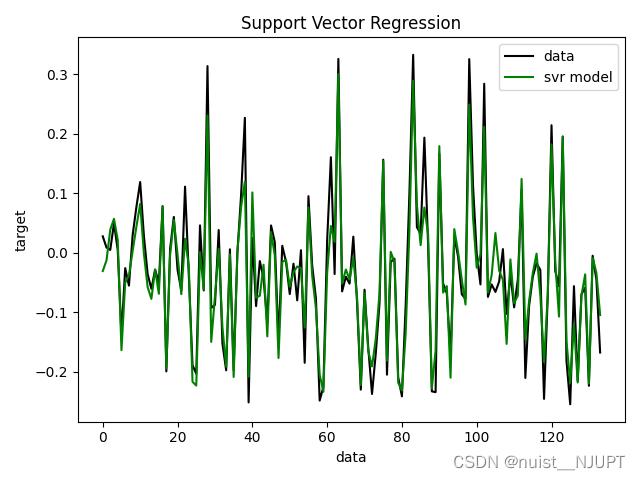
预测的值和真实值之间的误差变化图,具体如下:
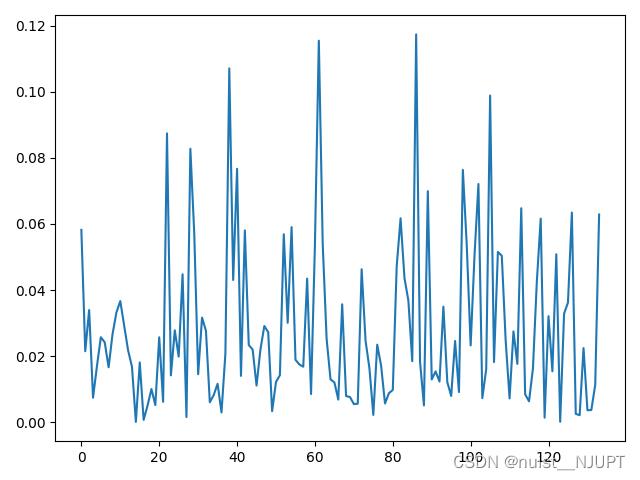
六、基于prophet的时间序列预测
6.1、prophet理论与实现一
我们可以看一下Prophet模型进行时间序列预测的基本模型,具体包括趋势项,周期项,节假日项,误差项,四个项目共同组成prophet模型。

我们根据原始时间序列数据去预测后30天的申购总额和赎回总额,原始数据是2013年7月到2014年的8月,我们使用当前的时间序列数据预测未来30天的,具体如下:

python代码实现如下:
import pandas as pd
import numpy as np
import matplotlib.pyplot as plt
from prophet import Prophet
from prophet.diagnostics import cross_validation
from prophet.diagnostics import performance_metrics
from prophet.plot import plot_cross_validation_metric
import warnings
warnings.filterwarnings('ignore')
#读取数据
data_user = pd.read_csv('user_balance_table.csv')
#将第一列的时间数据转换成固定格式
data_user['report_date'] = pd.to_datetime(data_user['report_date'], format='%Y%m%d')
#输出前面的头部信息
print(data_user.head())
#取时间列和另外要预测的两列
data_user_byday = data_user.groupby(['report_date'])['total_purchase_amt','total_redeem_amt'].sum().sort_values(['report_date']).reset_index()
print(data_user_byday.head())
# 定义模型
def FB(data: pd.DataFrame) -> pd.DataFrame:
df = pd.DataFrame(
'ds': data.report_date,
'y': data.total_purchase_amt,
)
#申购总额的最大值和最小值
df['cap'] = data.total_purchase_amt.values.max()
df['floor'] = data.total_purchase_amt.values.min()
m = Prophet(
changepoint_prior_scale=0.05,
daily_seasonality=False,
yearly_seasonality=True, # 年周期性
weekly_seasonality=True, # 周周期性
growth="logistic",
)
m.add_seasonality(name='monthly', period=30.5, fourier_order=5, prior_scale=0.1)#月周期性
m.add_country_holidays(country_name='CN') # 中国所有的节假日
m.fit(df)
future = m.make_future_dataframe(periods=30, freq='D') # 预测时长
#预测的申购总额的最大值和最小值
future['cap'] = data.total_purchase_amt.values.max()
future['floor'] = data.total_purchase_amt.values.min()
forecast = m.predict(future)
fig = m.plot_components(forecast)
fig1 = m.plot(forecast)
return forecast
result_purchase = FB(data_user_byday)
print(result_purchase)
plt.show()
预测结果如下:
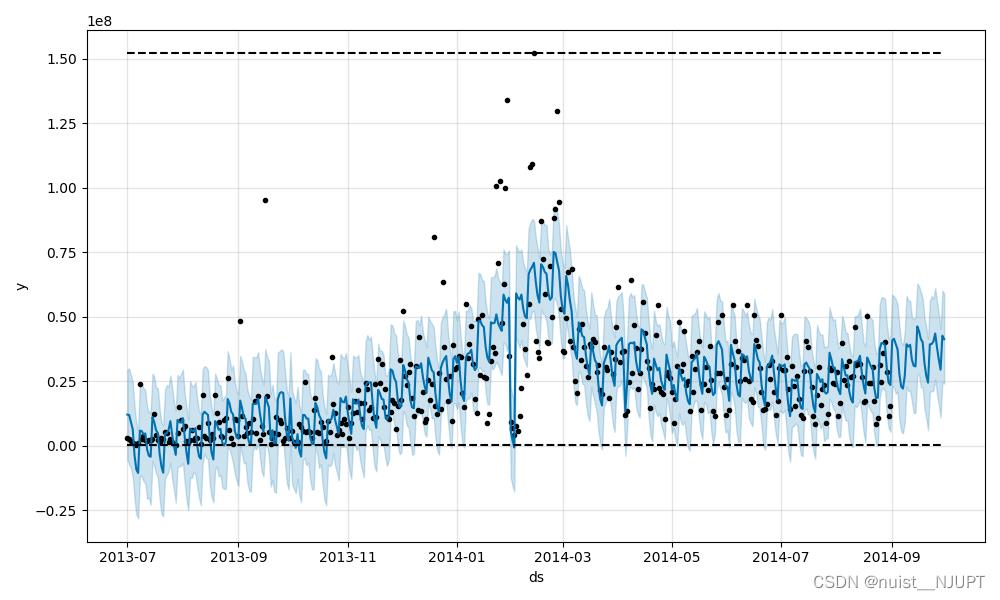
预测的周期性和趋势图等如下:
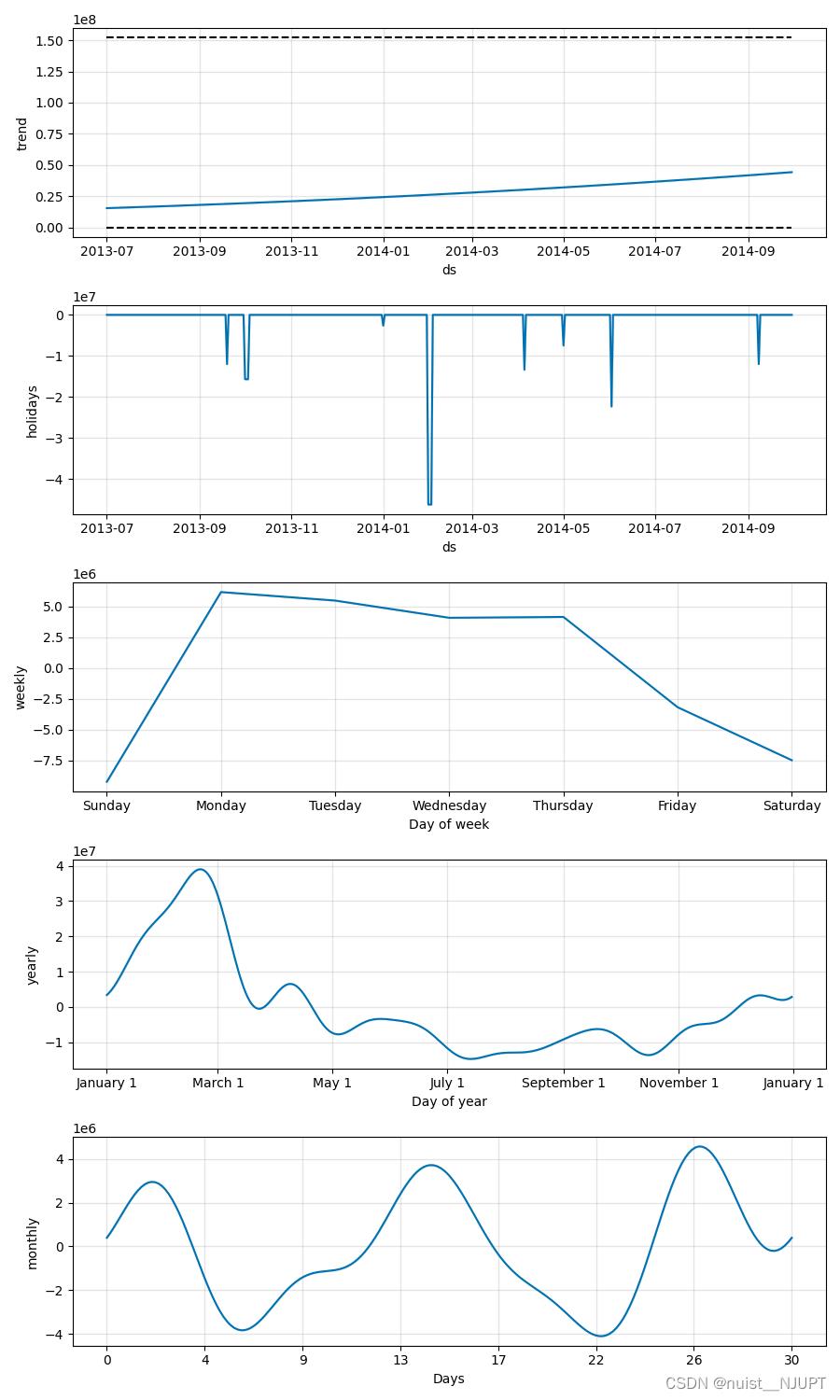 6.2、 prophet理论与实现二
6.2、 prophet理论与实现二
数据部分,2013年7月到2014年8月的数据,对后30天的赎回总额进行预测,具体如下:

python代码如下:
import pandas as pd
import numpy as np
import matplotlib.pyplot as plt
from prophet import Prophet
from prophet.diagnostics import cross_validation
from prophet.diagnostics import performance_metrics
from prophet.plot import plot_cross_validation_metric
import warnings
warnings.filterwarnings('ignore')
#读取数据
data_user = pd.read_csv('user_balance_table.csv')
#将第一列的时间数据转换成固定格式
data_user['report_date'] = pd.to_datetime(data_user['report_date'], format='%Y%m%d')
#输出前面的头部信息
print(data_user.head())
#取时间列和另外要预测的两列
data_user_byday = data_user.groupby(['report_date'])['total_purchase_amt','total_redeem_amt'].sum().sort_values(['report_date']).reset_index()
print(data_user_byday.head())
# 定义模型
def FB(data: pd.DataFrame) -> pd.DataFrame:
df = pd.DataFrame(
'ds': data.report_date,
'y': data.total_redeem_amt,
)
df['cap'] = data.total_redeem_amt.values.max()
df['floor'] = data.total_redeem_amt.values.min()
m = Prophet(
changepoint_prior_scale=0.05,
daily_seasonality=False,
yearly_seasonality=True, # 年周期性
weekly_seasonality=True, # 周周期性
growth="logistic",
)
#365/12
m.add_seasonality(name='monthly', period=30.5, fourier_order=5, prior_scale=0.1) # 月周期性
m.add_country_holidays(country_name='CN' ) # 中国所有的节假日
m.fit(df)
future = m.make_future_dataframe(periods=30, freq='D' ) # 预测时长
future['cap'] = data.total_redeem_amt.values.max()
future['floor'] = data.total_redeem_amt.values.min()
forecast = m.predict(future)
fig = m.plot_components(forecast)
fig1 = m.plot(forecast)
return forecast
result_redeem = FB(data_user_byday)
print(result_redeem)
plt.show()预测结果如下:
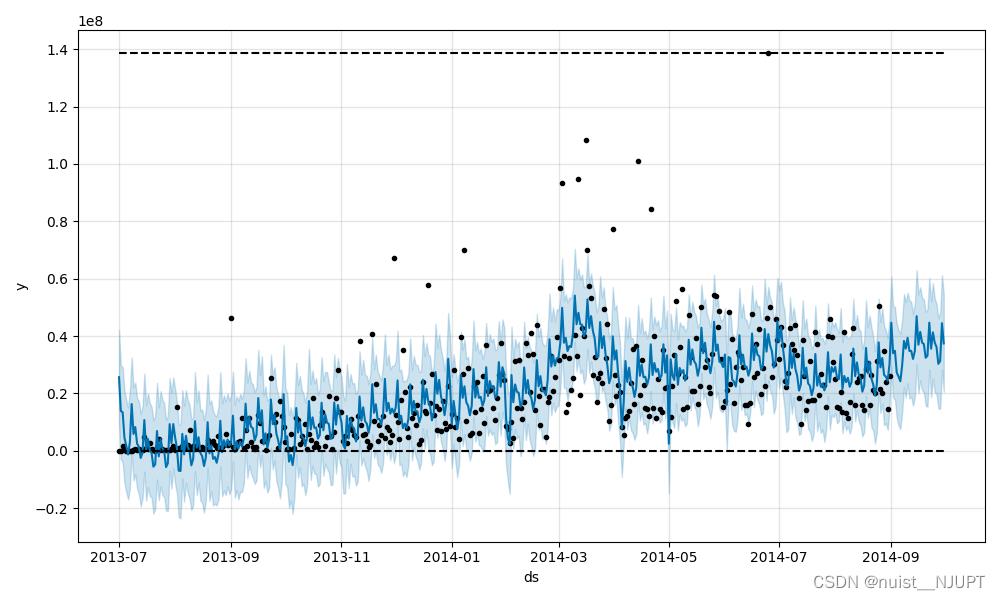
周期性分析结果如下: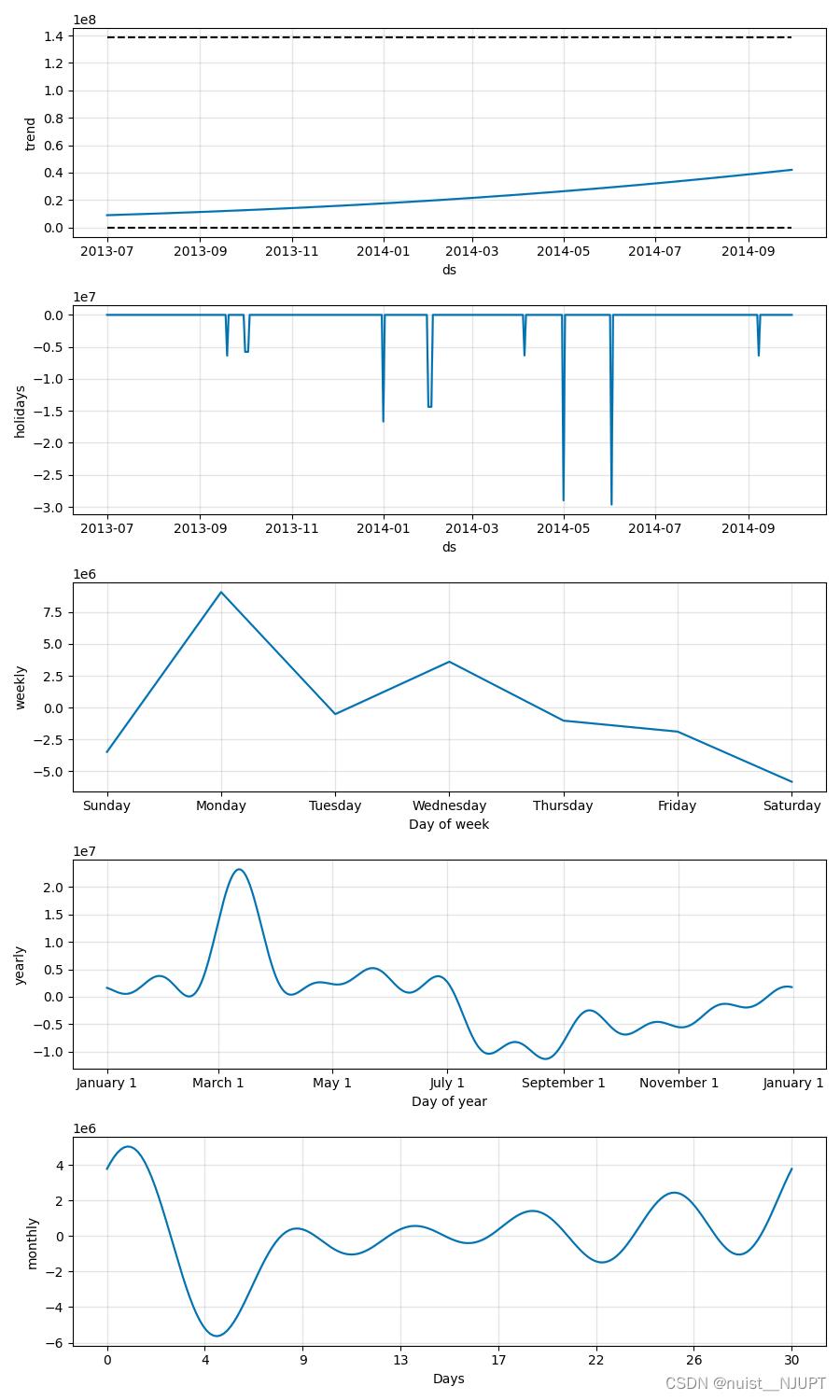
七、图像处理方法
7.1、图像的去噪、增强
1、去噪是采用滤波的方式,本文使用了三种滤波方式:均值滤波,中值滤波,高斯高通滤波,滤波的主要代码如下,滤波的主要效果展示在图片中:
clear;
clc
g = imread('bird.jpg');
gg = imnoise(g, 'gaussian'); %添加高斯噪声
subplot(2,2,1);
imshow(gg);
title('高斯噪声');
j = 2;
for i = 3:4:11
subplot(2,2,j);
G = avefilter(gg, i);
imshow(G);
title([num2str(i), '\\ast', num2str(i), '均值滤波']);
j = j+1;
end
figure(2);
g = imread('bird.png');
gg = imnoise(g, 'salt & pepper', 0.05); %添加椒盐噪声
subplot(2,2,1), imshow(gg);
title('椒盐噪声');
j = 2;
for i = 3:4:11
G = medianfilter(gg, i);
subplot(2,2,j);
imshow(G);
title([num2str(i), '\\ast', num2str(i), '中值滤波']);
j = j+1;
end
figure(3);
d0=50; %阈值
image=imread('bird.jpg');
[M,N,P] = size(image);
img_f = fft2(double(image));%傅里叶变换得到频谱
img_f=fftshift(img_f); %移到中间
m_mid=floor(M/2);%中心点坐标
n_mid=floor(N/2);
h = zeros(M,N,P);%高斯低通滤波器构造
for i = 1:M
for j = 1:N
d = ((i-m_mid)^2+(j-n_mid)^2);
h(i,j) = exp(-d/(2*(d0^2)));
end
end
img_lpf = h.*img_f;
img_lpf=ifftshift(img_lpf); %中心平移回原来状态
img_lpf=uint8(real(ifft2(img_lpf))); %反傅里叶变换,取实数部分
subplot(1,2,1);
imshow(image);
title('原图');
subplot(1,2,2);
imshow(img_lpf);
title('高斯低通滤波d=50');function G = avefilter(F, k)
% F 是待处理的图像
% k 是模版的大小,奇数
[m,n,p] = size(F) ;
% 转换数据类型,便于计算
G = uint16(zeros(m, n));
Ft = uint16(F);
M = uint16(ones(k, k));
h = (k+1)/2;
for i = 1:m
for j = 1:n
if((i < h)|| (j < h)|| (i > m-h+1)|| (j > n-h+1)) %不能被模版处理的区域
G(i, j) = Ft(i, j);
continue; %像素值不变
end
%取同样大小的图像块,中间的像素是待处理的像素
T = Ft(i-(k-1)/2: i+(k-1)/2, j-(k-1)/2: j+(k-1)/2);
T = T.*M; %和模版相乘
G(i, j) = sum(T(:))/k^2; %结果求和并计算平均值
end
end
G = uint8(G); %结果转换成8-bit图像的数据类型function G = medianfilter(F, k)
% F 是待处理的图像
% k 是模版的大小,奇数
[m,n,p] = size(F) ;
% 转换数据类型,便于计算
G = uint16(zeros(m, n)); Ft = uint16(F); M = uint16(ones(k, k));
h = (k+1)/2;
for i = 1:m
for j = 1:n
if((i < h)|| (j < h)|| (i > m-h+1)|| (j > n-h+1)) %不能被模版处理的区域
G(i, j) = Ft(i, j);
continue; %像素值不变
end
% 取同样大小的图像块,中间的像素是待处理的像素
T = Ft(i-(k-1)/2: i+(k-1)/2, j-(k-1)/2: j+(k-1)/2);
T = T(:); %将矩阵转换为一维向量
G(i, j) = median(T); %求中值并赋值给中间像素
end
end
G = uint8(G); %结果转换成8-bit图像的数据类型滤波效果如下:
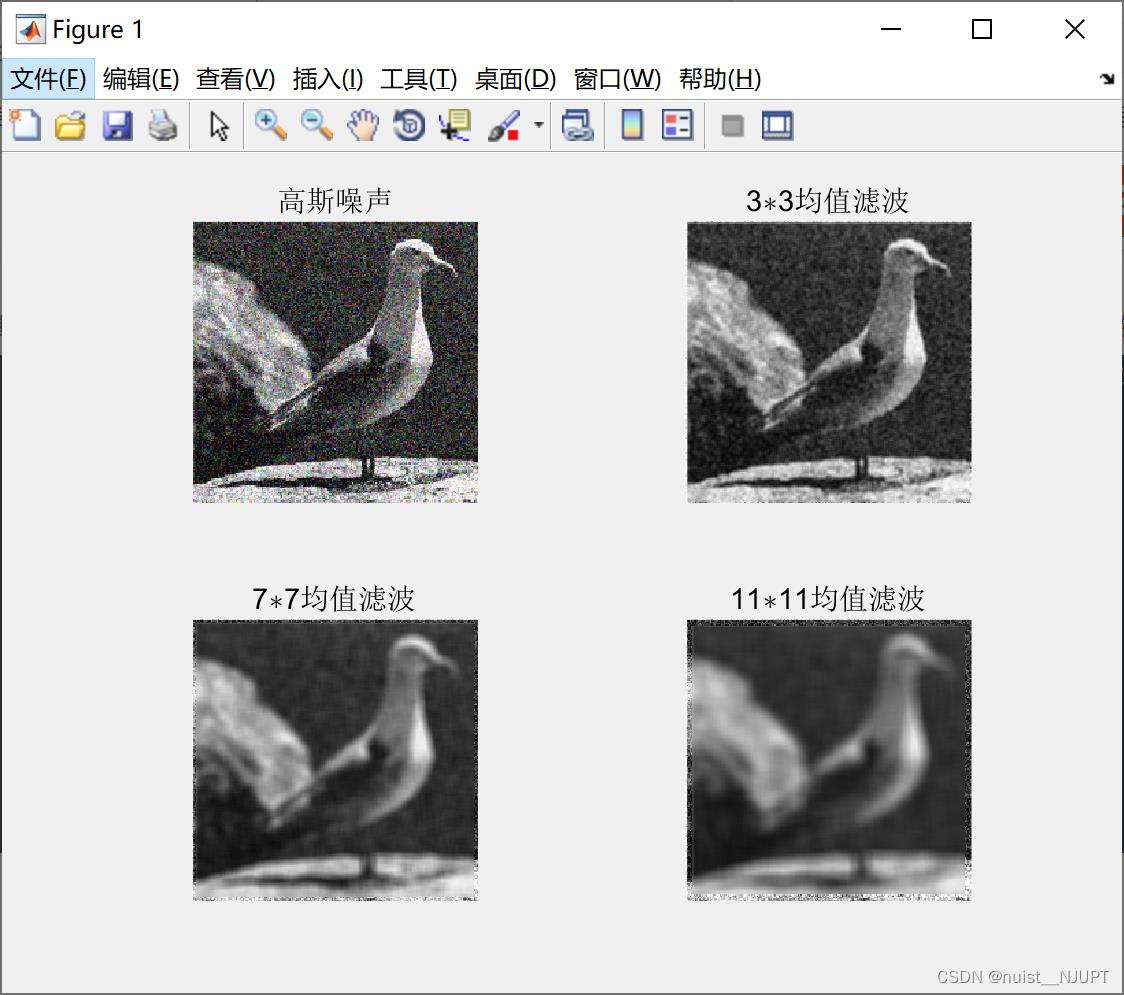

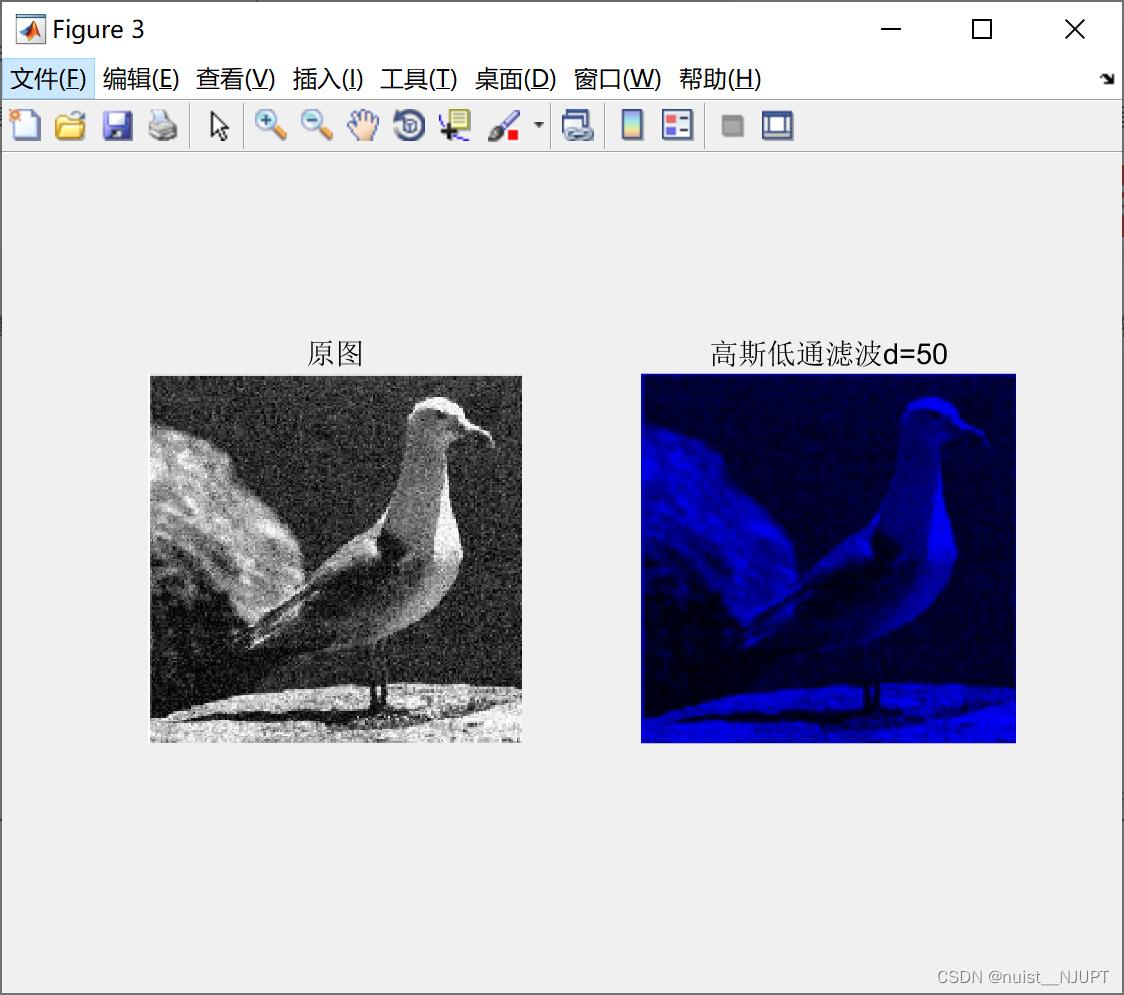
2-接下来对图像进行增强处理, 主要采用两种方式,一种是灰度线性变换,另外一种是直方图均衡变换。
matlab实现灰度线性变换和直方图均衡变换进行图像增强的代码如下:
%% 获取灰色图像直方图
I = imread('bird.jpg'); %读取图片
I = rgb2gray(I); %把图片从rgb格式转为灰度图
row = size(I, 1); %获取图片像素的行列数
column = size(I, 2);
N = zeros(1, 256); %一个空的容器,用来记录每个像素出现的次数
% 两个循环用来遍历每一个像素
for i = 1:row
for j = 1:column
k = I(i, j); % 获取该像素点的像素值
N(k + 1) = N(k + 1) + 1; % 记录下该像素值出现的次数
end
end
%展示图片
figure(1);
subplot(121);imshow(I);
subplot(122);bar(N);
%% 灰色线性变换进行图像增强
I = imread('bird.jpg');
I = rgb2gray(I);
I = double(I);
J = (I - 80) * 255 / 70;
row = size(I, 1);
column = size(I, 2);
for i = 1:row
for j = 1:column
if J(i, j) < 0
J(i, j) = 0;
elseif J(i, j) > 255
J(i, j) = 255;
end
end
end
figure(2);
subplot(121);imshow(uint8(I));
subplot(122);imshow(uint8(J));
%% 直方图均衡变换进行图像增强
%R,G,B直方图展示
figure(3) ;
I = imread('bird.jpg');
subplot(221);imshow(I);
subplot(222);imhist(I(:, :, 1));title('R');
subplot(223);imhist(I(:, :, 2));title('G');
subplot(224);imhist(I(:, :, 3));title('B');
%均衡化方法
I = imread('bird.jpg');
G = rgb2gray(I) ;
J = histeq(G);
figure(4);
subplot(221);imshow(G);
subplot(222);imshow(J);
subplot(223);imhist(G);
subplot(224);imhist(J);
效果图如下:
原始图像和原始图像的灰色直方图如下:
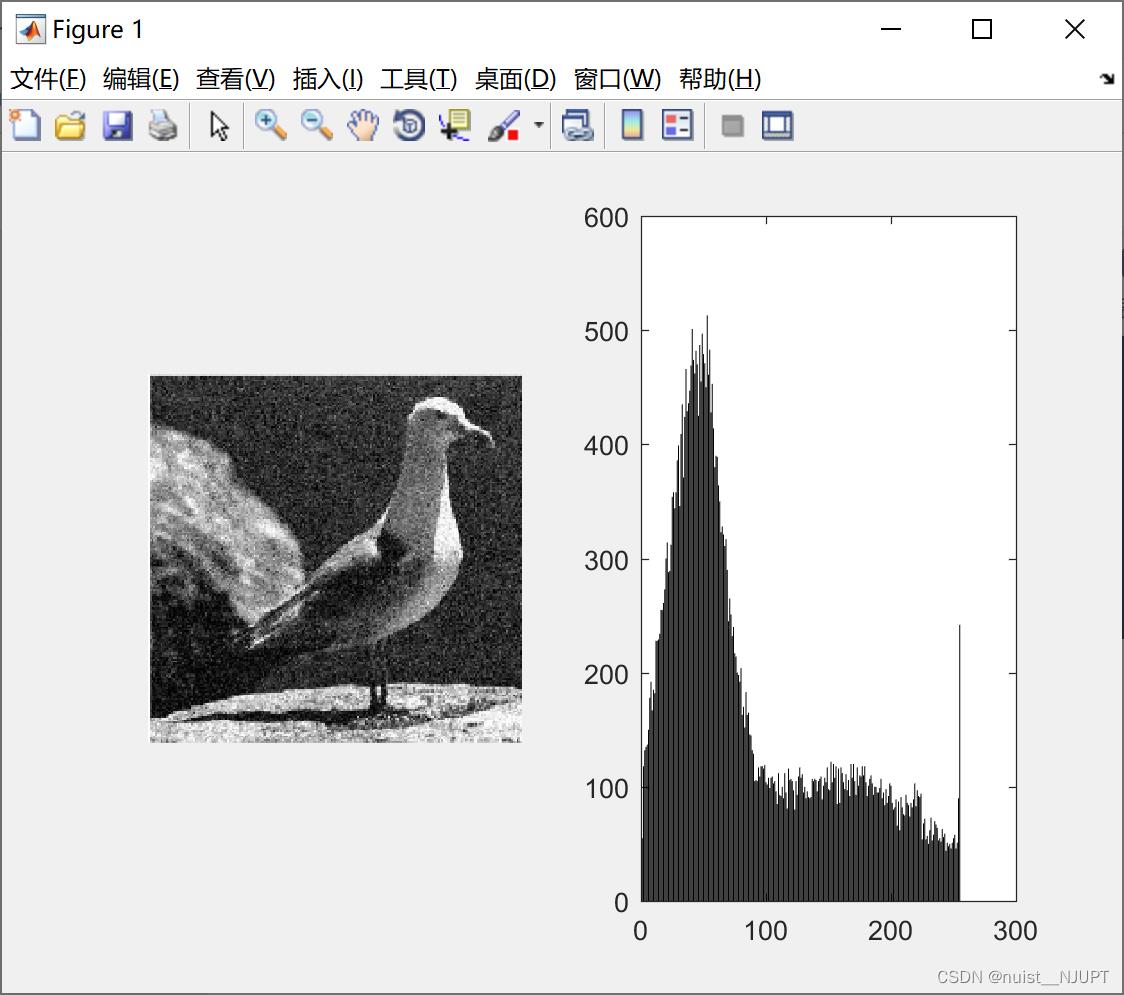
对图像做了灰色线性变换后的图像对比如下:
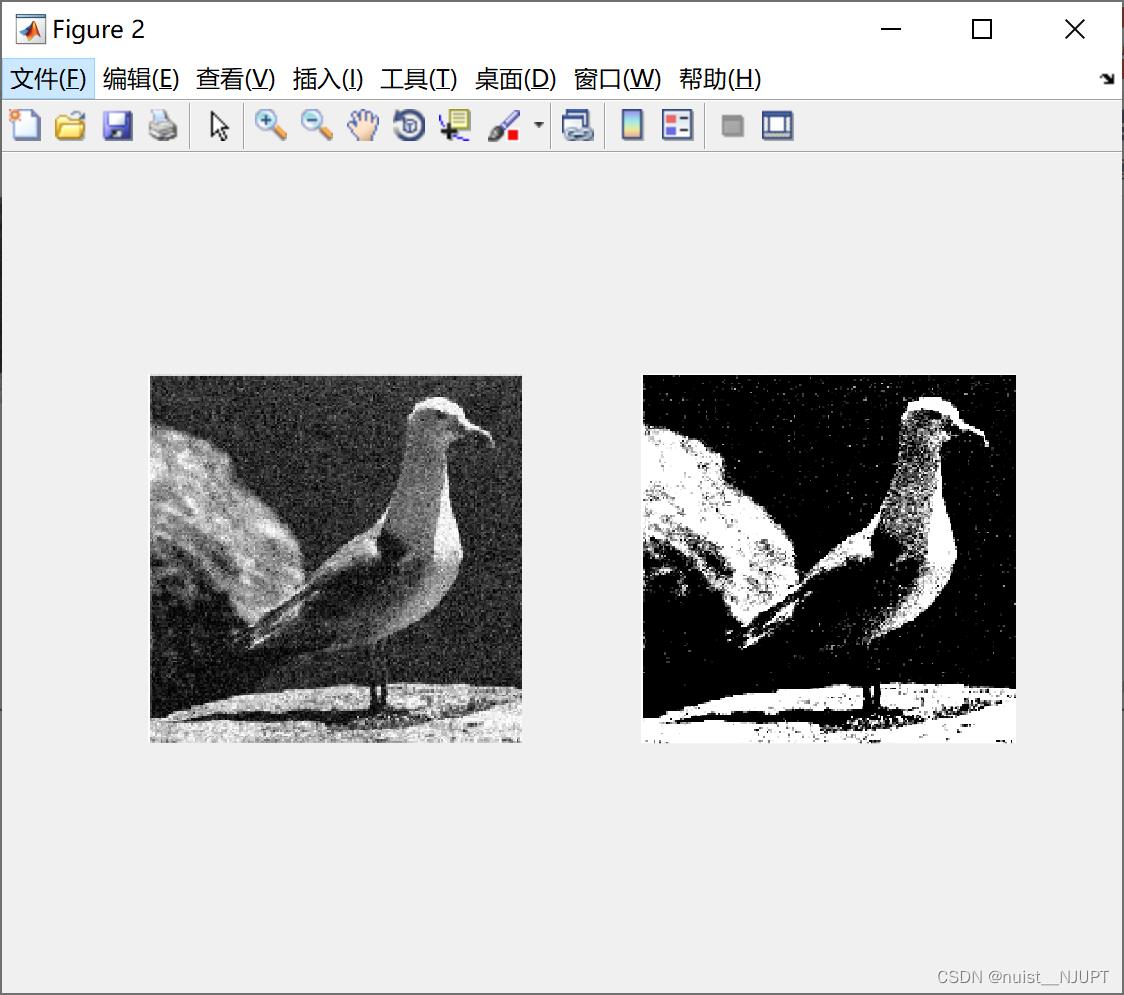
原始图像的RGB直方图如下:

对原始图像做了直方图均衡变换的效果图:
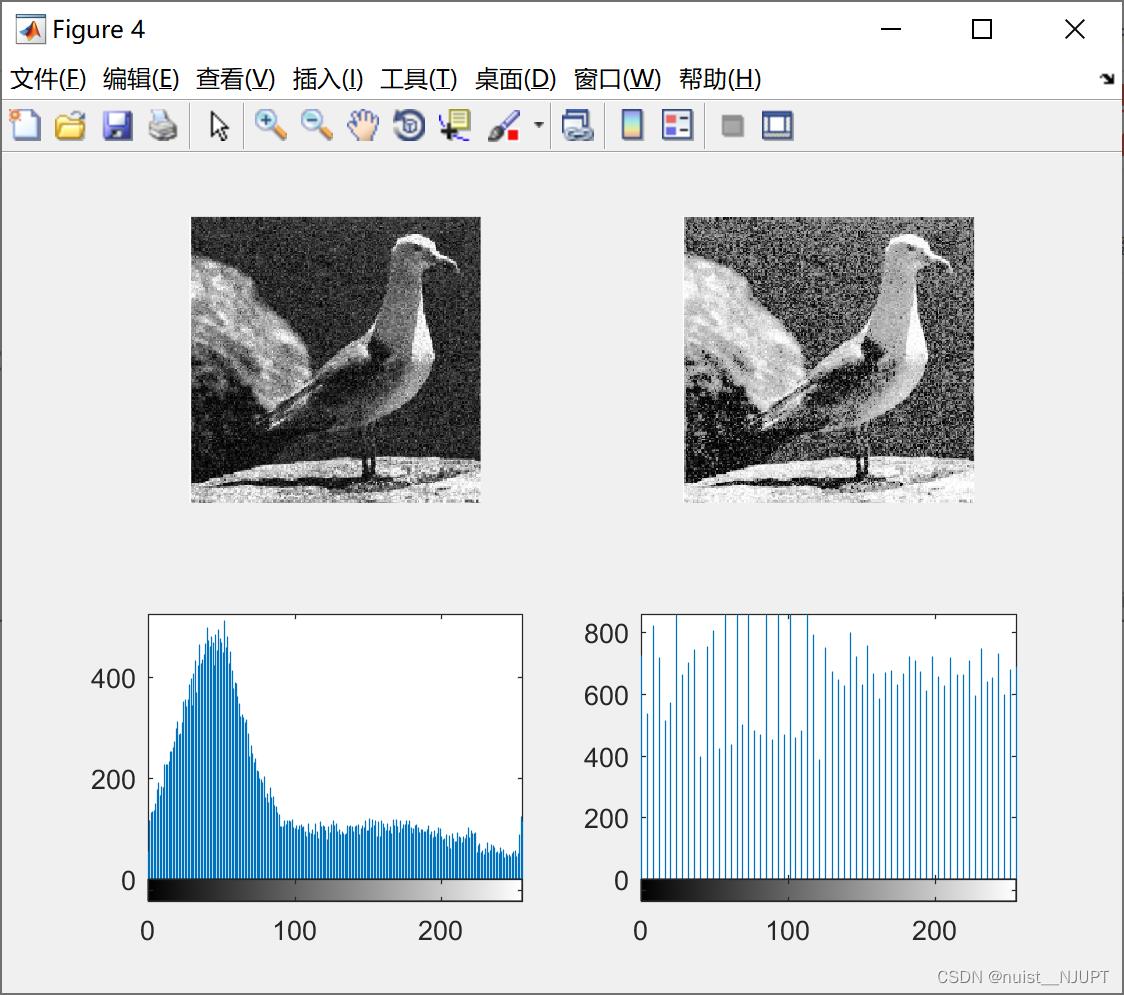
7.2、图像特征提取
使用SITF算法进行图像特征提取,提取的特征位置如下,具体的matlab代码如下:
我们先看一下提取的效果:
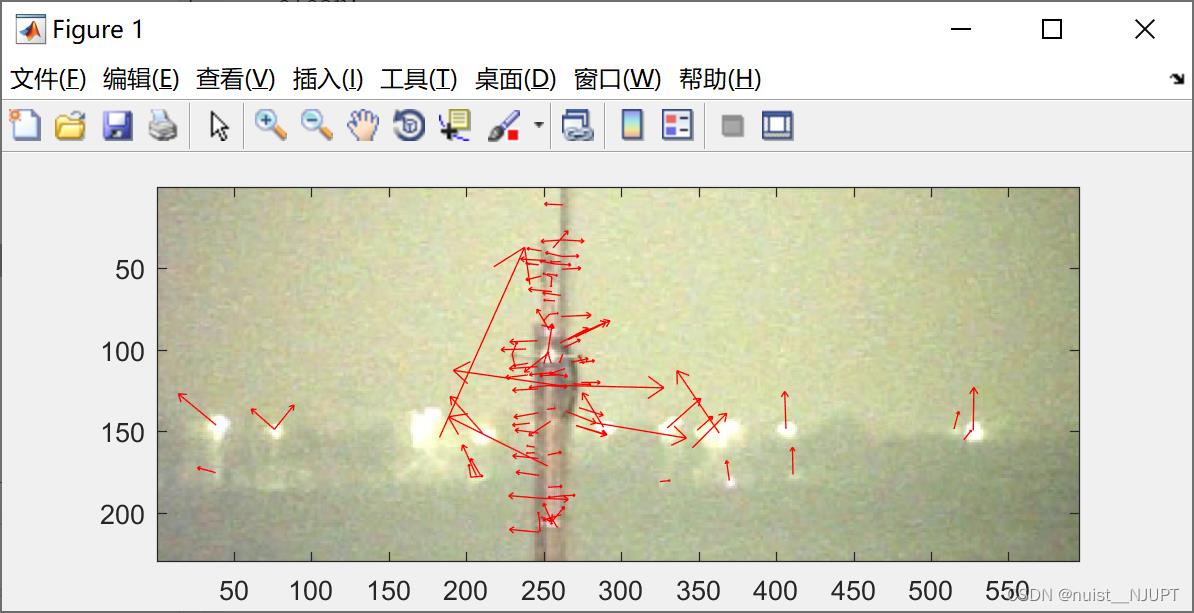
主函数如下:
clear;
clc
[image, descriptors, locs] = sift('deng.jpg');
disp('descriptors如下:') ;
disp(descriptors) ;
image1 = imread('deng.jpg');
showkeys(image1, locs)sift算法函数如下:
% [image, descriptors, locs] = sift(imageFile)
%
% This function reads an image and returns its SIFT keypoints.
% Input parameters:
% imageFile: the file name for the image.
%
% Returned:
% image: the image array in double format
% descriptors: a K-by-128 matrix, where each row gives an invariant
% descriptor for one of the K keypoints. The descriptor is a vector
% of 128 values normalized to unit length.
% locs: K-by-4 matrix, in which each row has the 4 values for a
% keypoint location (row, column, scale, orientation). The
% orientation is in the range [-PI, PI] radians.
%
% Credits: Thanks for initial version of this program to D. Alvaro and
% J.J. Guerrero, Universidad de Zaragoza (modified by D. Lowe)
function [image, descriptors, locs] = sift(imageFile)
% Load image
image1 = imread(imageFile);
image = rgb2gray(image1) ;
% If you have the Image Processing Toolbox, you can uncomment the following
% lines to allow input of color images, which will be converted to grayscale.
% if isrgb(image)
% image = rgb2gray(image);
% end
[rows, cols] = size(image);
% Convert into PGM imagefile, readable by "keypoints" executable
f = fopen('tmp.pgm', 'w');
if f == -1
error('Could not create file tmp.pgm.');
end
fprintf(f, 'P5\\n%d\\n%d\\n255\\n', cols, rows);
fwrite(f, image', 'uint8');
fclose(f);
% Call keypoints executable
if isunix
command = '!./sift ';
else
command = '!siftWin32 ';
end
command = [command ' <tmp.pgm >tmp.key'];
eval(command);
% Open tmp.key and check its header
g = fopen('tmp.key', 'r');
if g == -1
error('Could not open file tmp.key.');
end
[header, count] = fscanf(g, '%d %d', [1 2]);
if count ~= 2
error('Invalid keypoint file beginning.');
end
num = header(1);
len = header(2);
if len ~= 128
error('Keypoint descriptor length invalid (should be 128).');
end
% Creates the two output matrices (use known size for efficiency)
locs = double(zeros(num, 4));
descriptors = double(zeros(num, 128));
% Parse tmp.key
for i = 1:num
[vector, count] = fscanf(g, '%f %f %f %f', [1 4]); %row col scale ori
if count ~= 4
error('Invalid keypoint file format');
end
locs(i, :) = vector(1, :);
[descrip, count] = fscanf(g, '%d', [1 len]);
if (count ~= 128)
error('Invalid keypoint file value.');
end
% Normalize each input vector to unit length
descrip = descrip / sqrt(sum(descrip.^2));
descriptors(i, :) = descrip(1, :);
end
fclose(g);特征点的展示函数如下:
% showkeys(image, locs)
%
% This function displays an image with SIFT keypoints overlayed.
% Input parameters:
% image: the file name for the image (grayscale)
% locs: matrix in which each row gives a keypoint location (row,
% column, scale, orientation)
function showkeys(image, locs)
disp('Drawing SIFT keypoints ...');
% Draw image with keypoints
figure('Position', [50 50 size(image,2) size(image,1)]);
colormap('gray');
imagesc(image);
hold on;
imsize = size(image);
for i = 1: size(locs,1)
% Draw an arrow, each line transformed according to keypoint parameters.
TransformLine(imsize, locs(i,:), 0.0, 0.0, 1.0, 0.0);
TransformLine(imsize, locs(i,:), 0.85, 0.1, 1.0, 0.0);
TransformLine(imsize, locs(i,:), 0.85, -0.1, 1.0, 0.0);
end
hold off;
% ------ Subroutine: TransformLine -------
% Draw the given line in the image, but first translate, rotate, and
% scale according to the keypoint parameters.
%
% Parameters:
% Arrays:
% imsize = [rows columns] of image
% keypoint = [subpixel_row subpixel_column scale orientation]
%
% Scalars:
% x1, y1; begining of vector
% x2, y2; ending of vector
function TransformLine(imsize,以上是关于备战数学建模50-终结篇(攻坚站15)的主要内容,如果未能解决你的问题,请参考以下文章